Settings
Settings
You can choose the Settings option from the Configuration menu by
clicking on it. Any PoS's parameters can be modified through this
window. You can do this by choosing the necessary PoS in the Point
of Sale field.
Use the +New Shop button to start a brand-new shop.
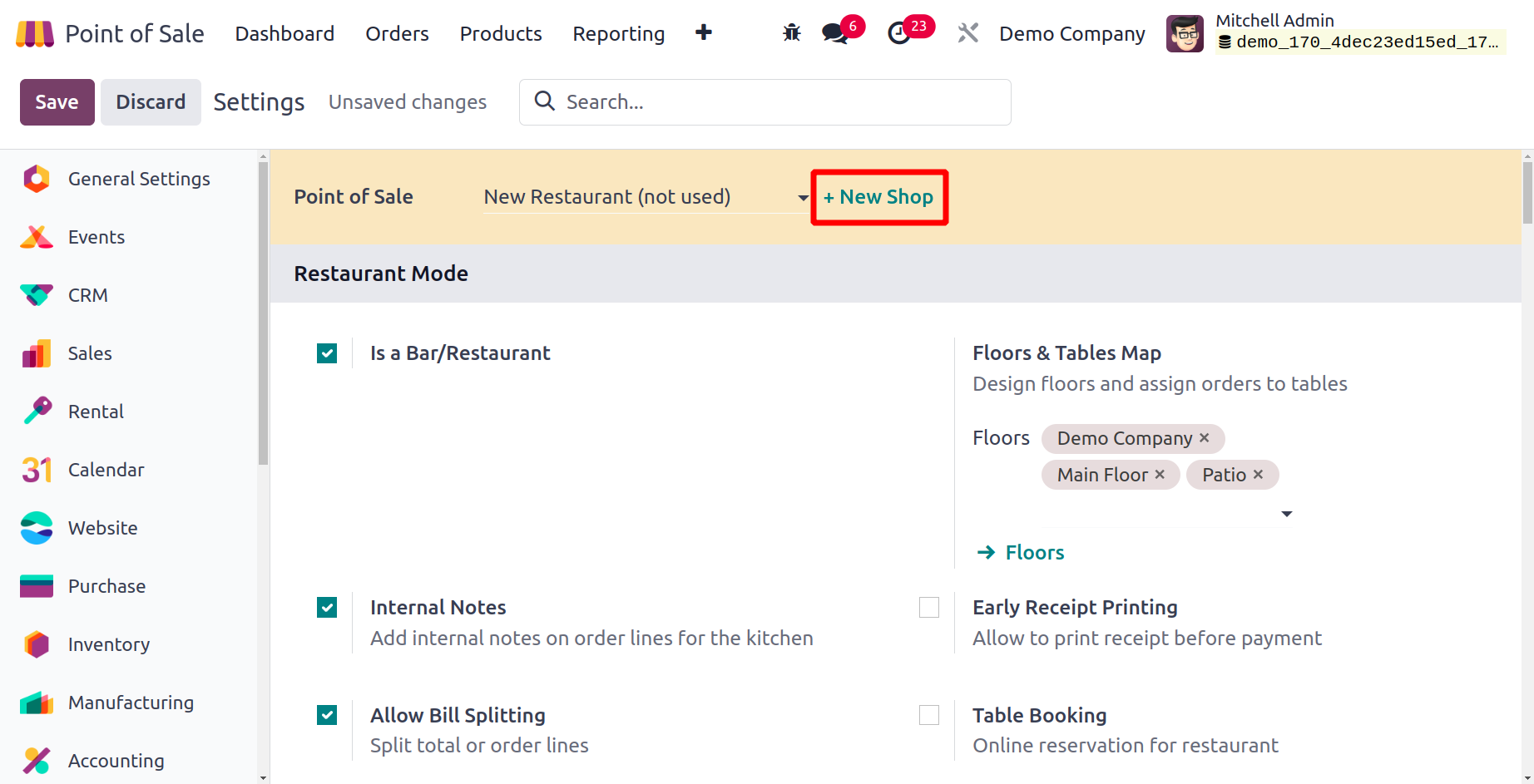
If any of these apply to the new shop, turn on the Is a
Bar/Restaurant field.
Restaurant Mode
You may access the Floors & Tables Map tool from the Restaurant & Bar
page to design floors and assign orders to tables. This page will
provide a link to an external page where you can control the shop's
floors.
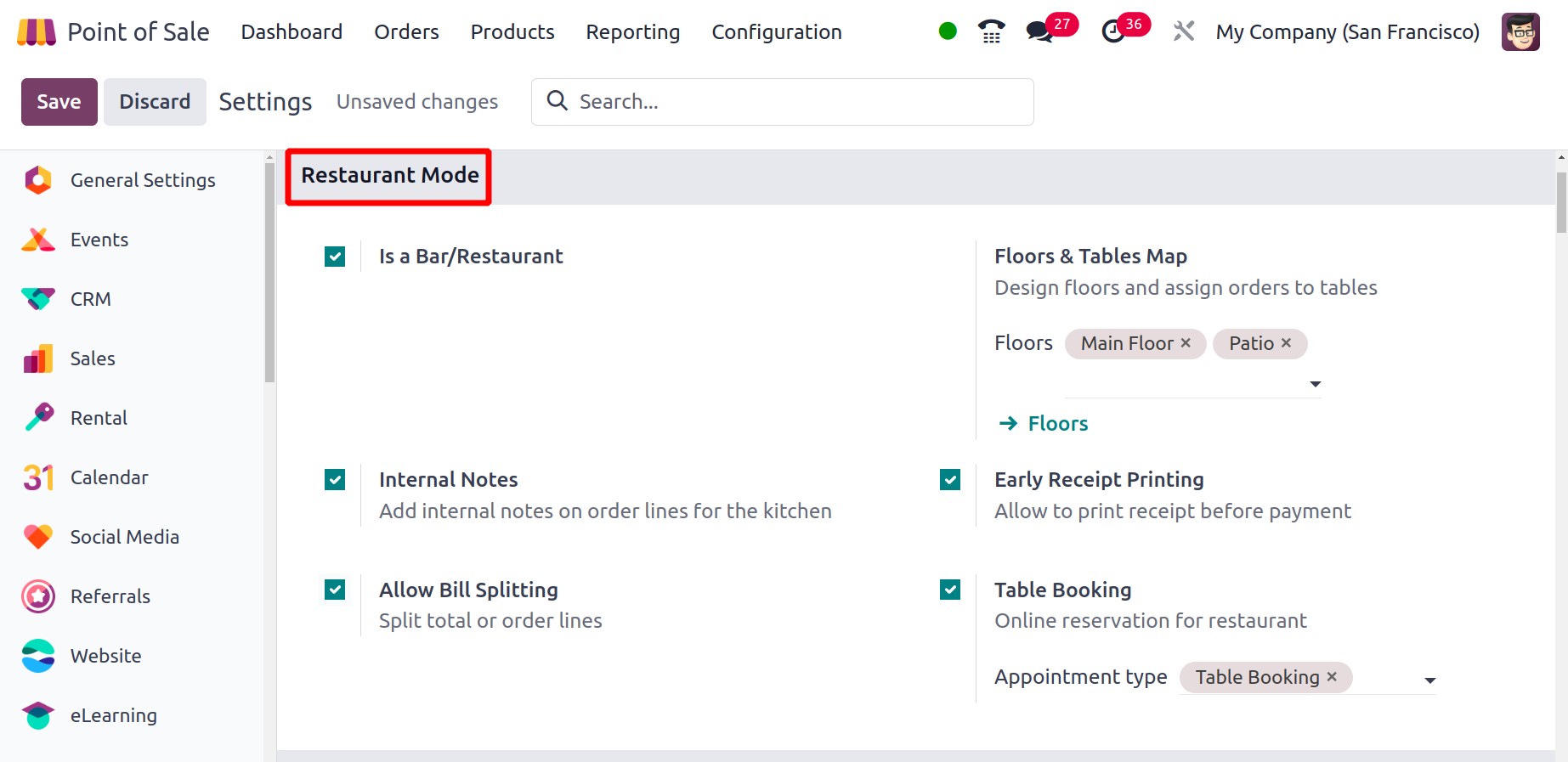
If you wish to add any internal comments from the borderline to the
kitchen, turn on the Internal comments option. A new button labeled
"Internal Notes" will show up inside the point of sale session
after the Internal Notes option has been enabled on the back end.
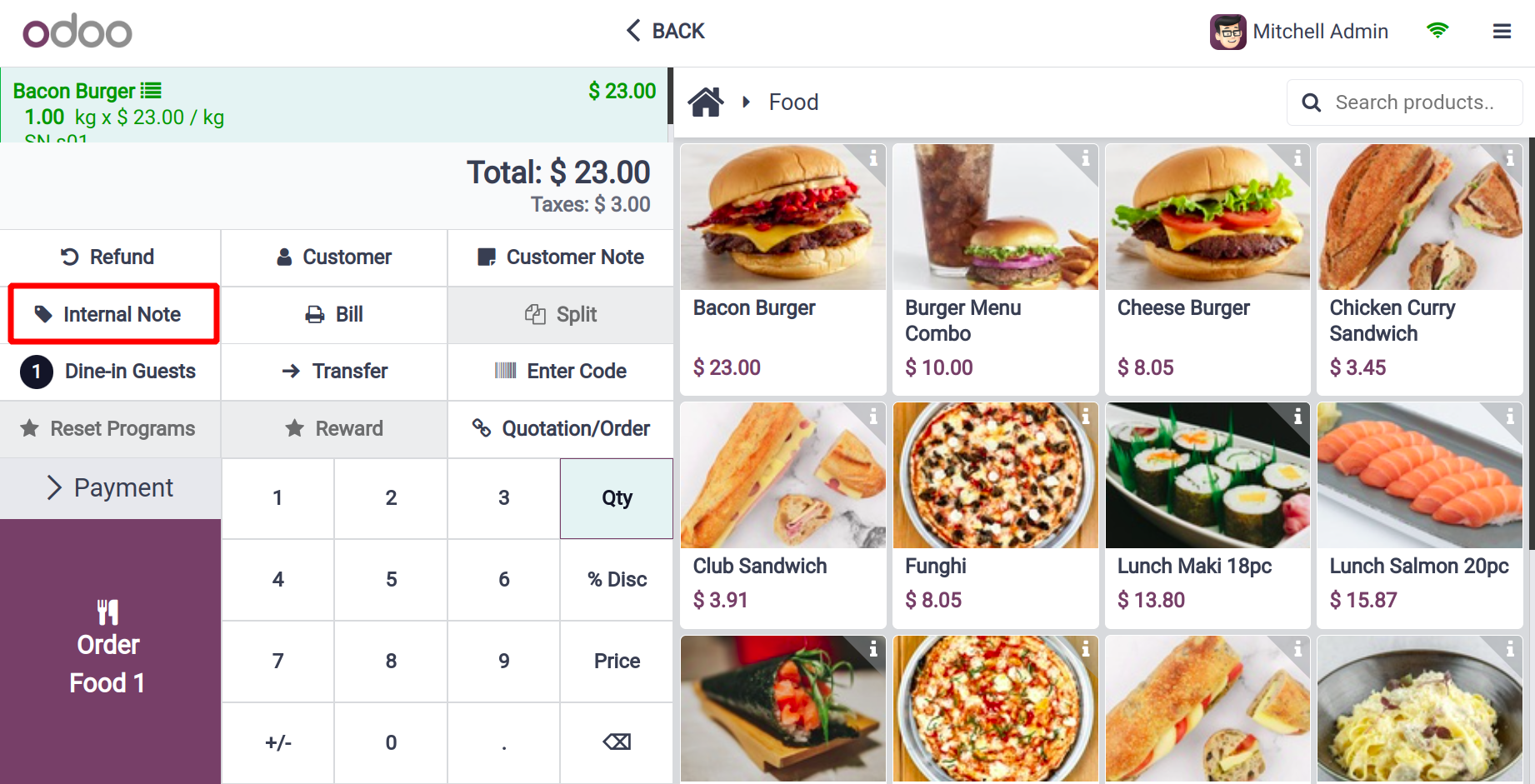
To add notes, click the Internal Notes icon after selecting the
product. In the Notes area, add notes to the kitchen by clicking the
Add button.
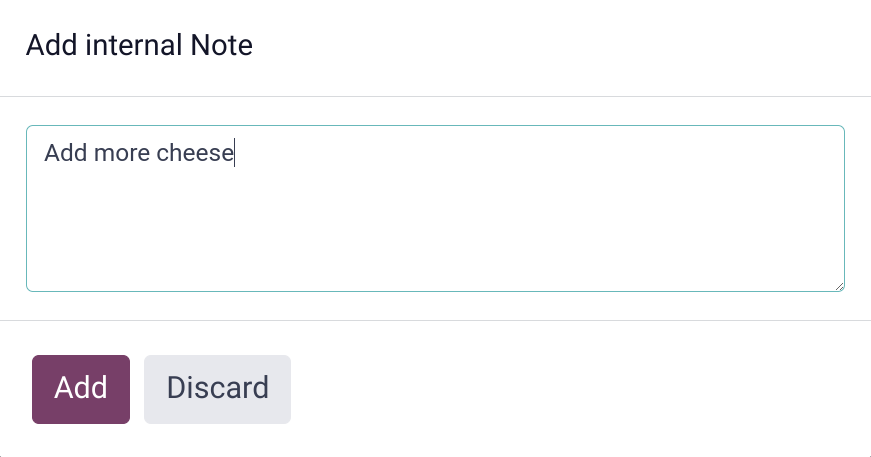
The note will then become visible, as the screenshot below
illustrates.
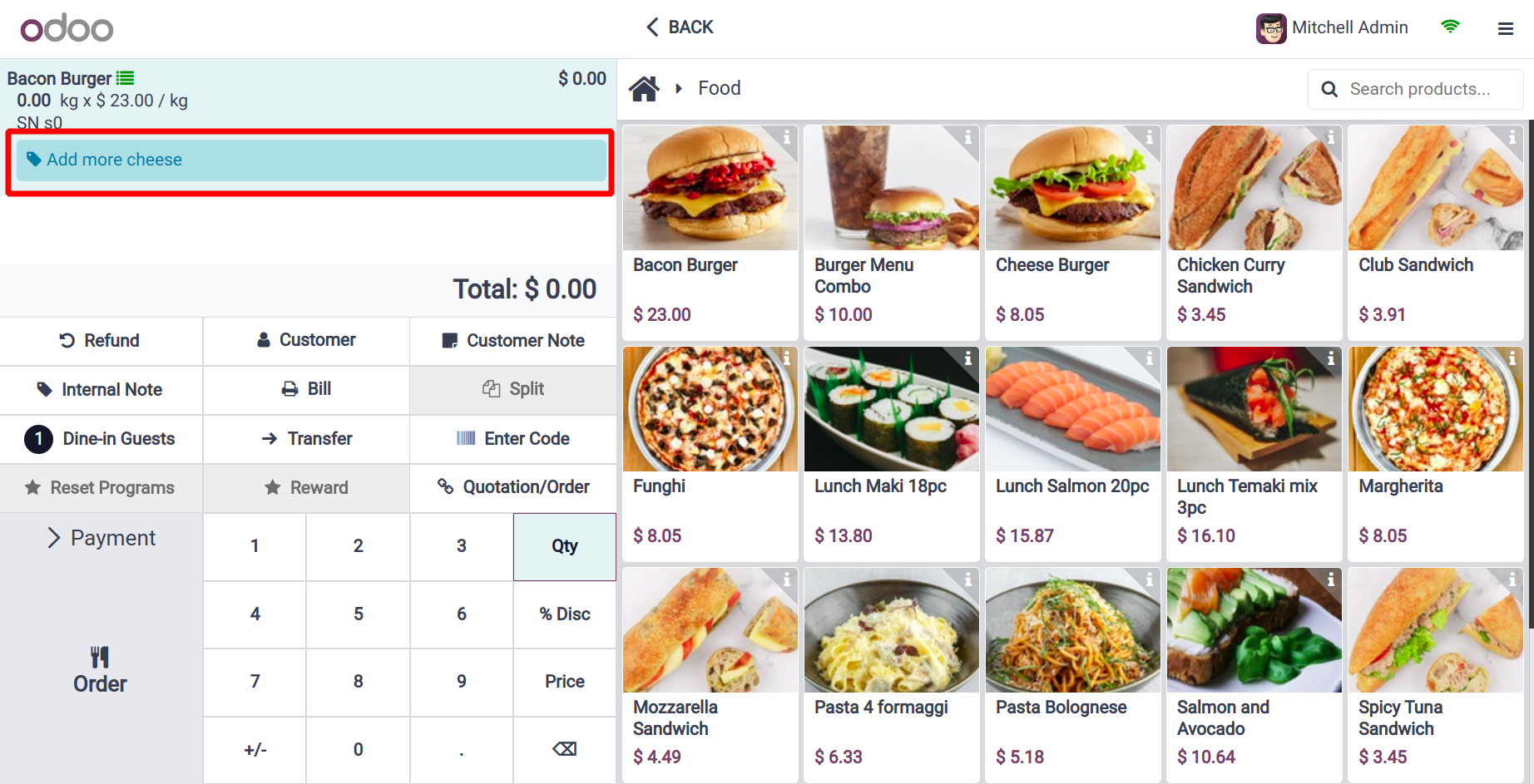
Activate the Early Receipt Printing option if you want to permit the
printing of receipts prior to payment.
You can use this choice to print receipts before making a purchase.
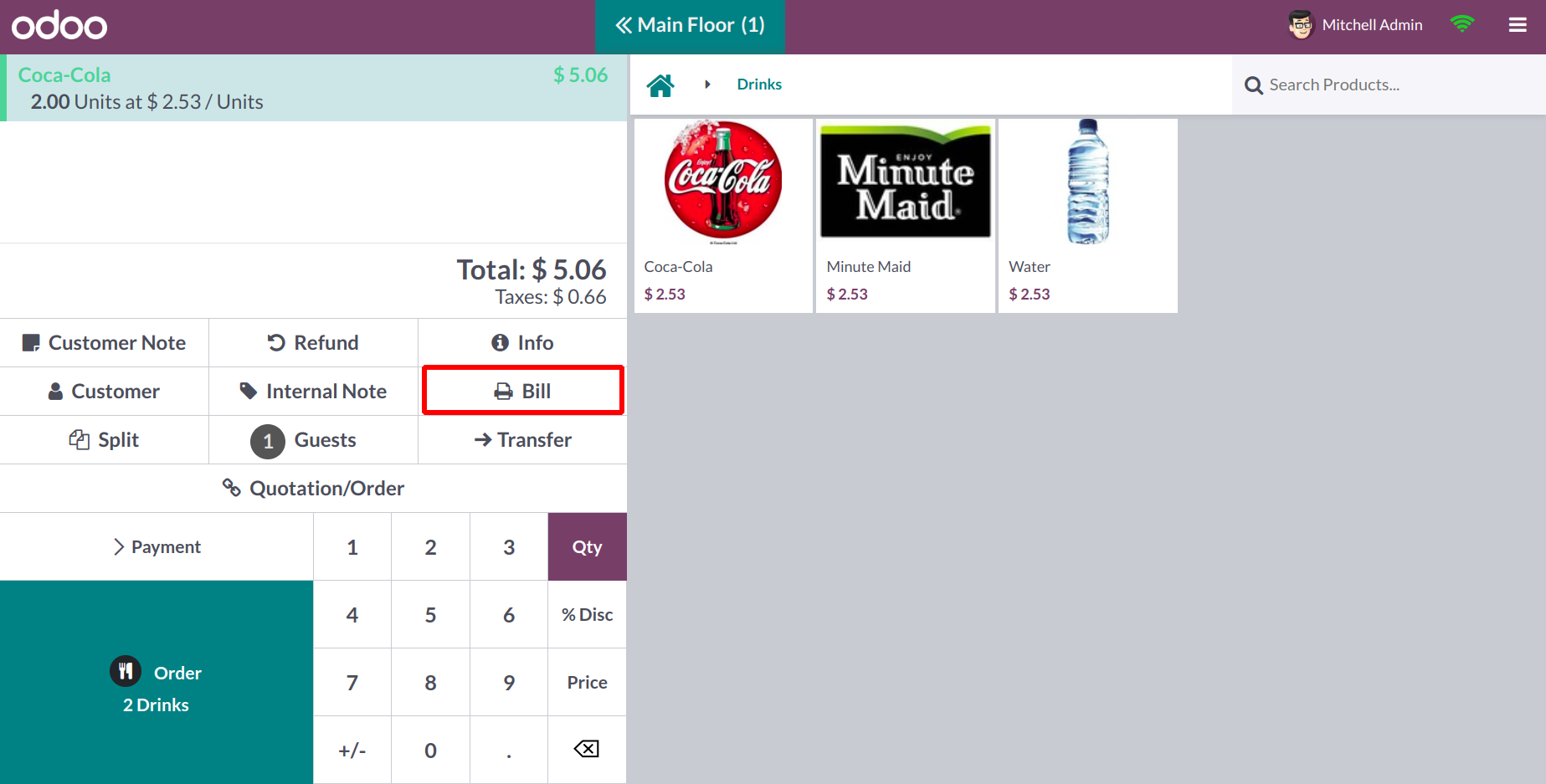
You can create a receipt for the order prior to making a payment
using the Bill option.
By turning on the Allow Bill Splitting option, it is possible to
divide the overall sum or individual order lines.
Table Booking is a brand-new feature that Odoo 17 offers. If enabled,
guests can make reservations for a table via the website. It
suggests that reservations can be made online by utilizing this
option.
Once the configuration has been saved, select the Appointment Type.
All of the created appointments will be visible to customers when
they visit the Appointment menu on the website. Toggle the relevant
one.
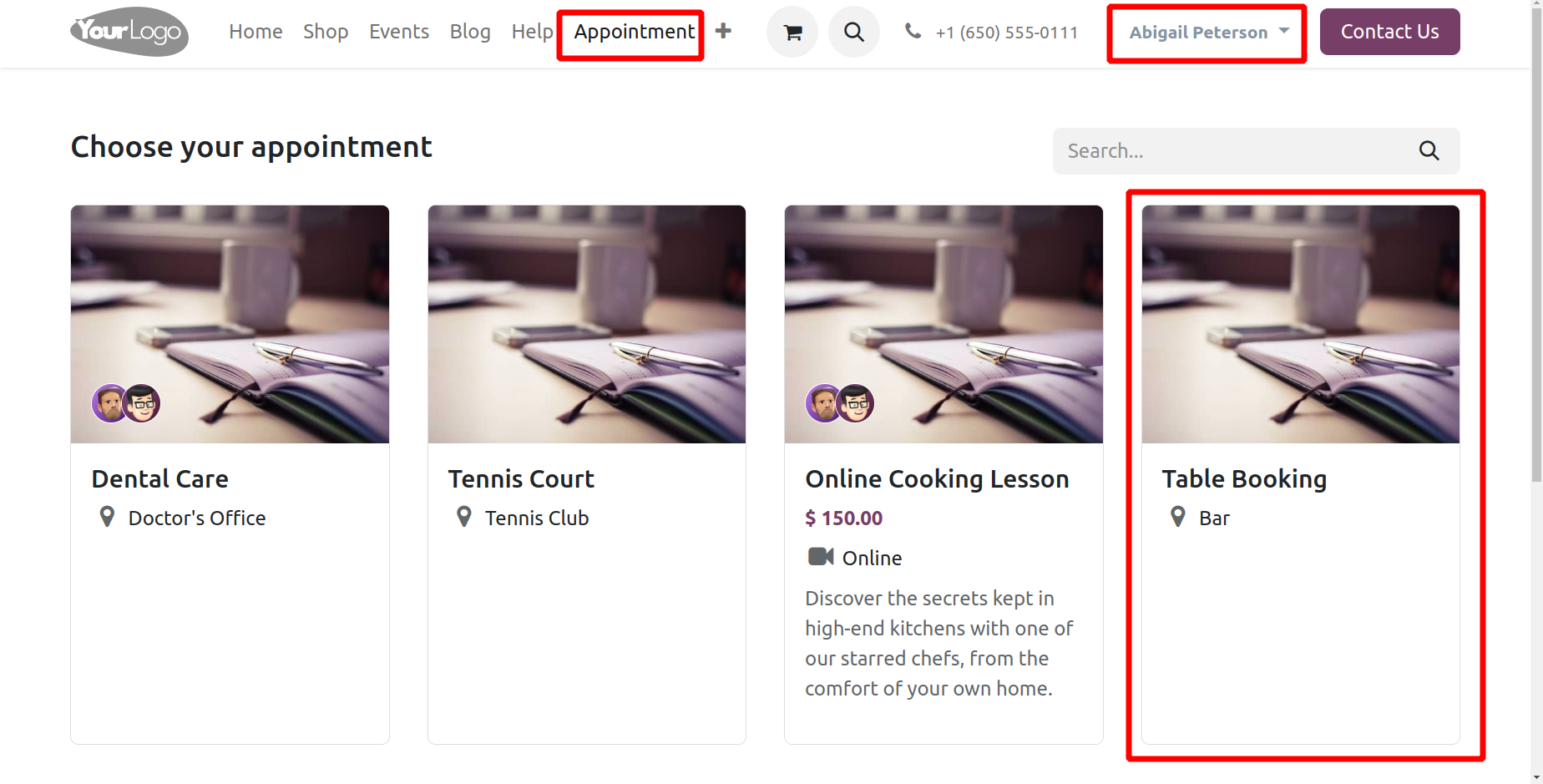
The customer can then select the reservation date and time on the
very next page. Many others made mention of it.
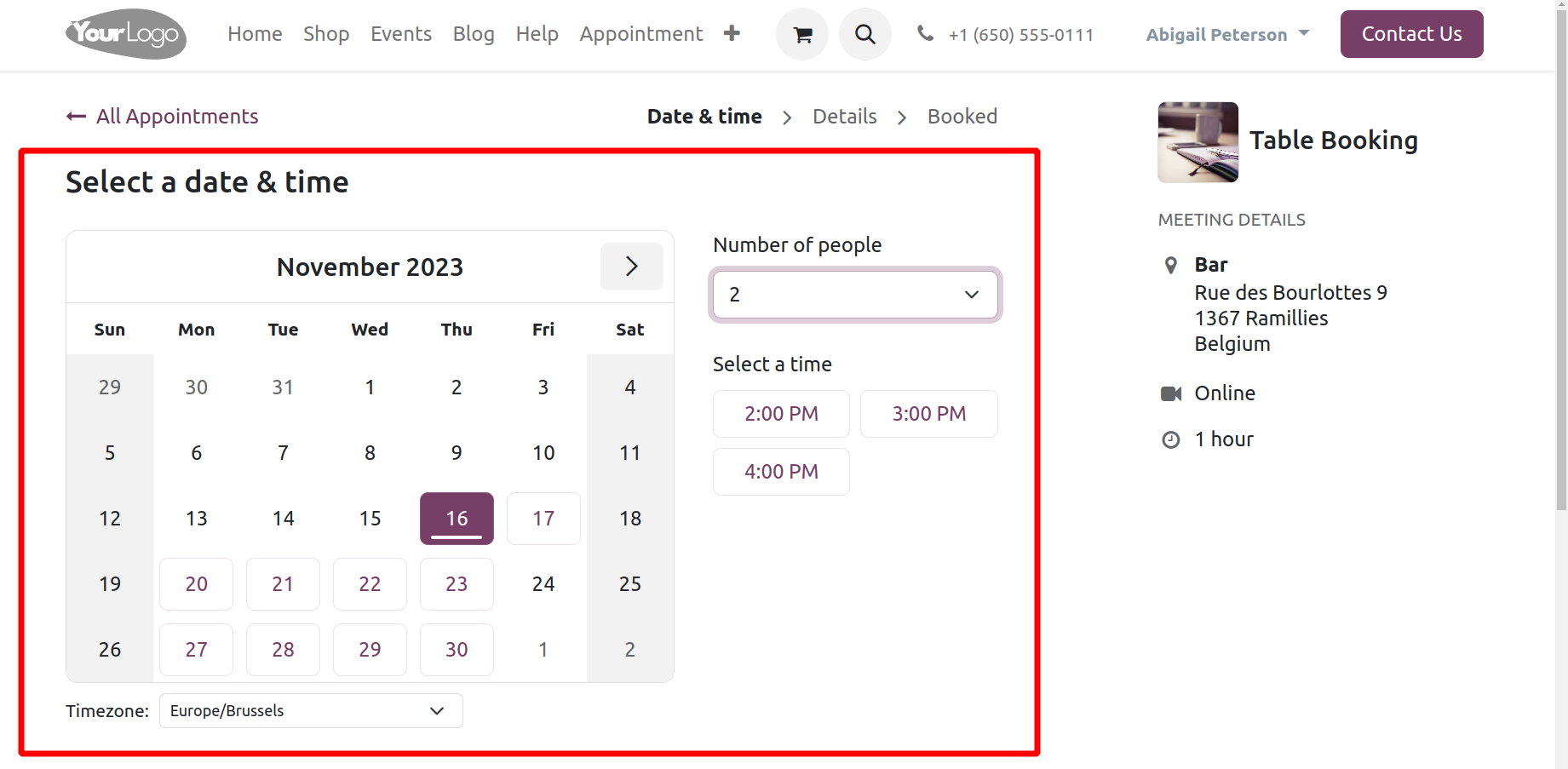
Subsequently, the client must provide their complete name, email
address, and phone number. Confirm the appointment once the data has
been completed. The customer receives the confirmation that is seen
below after completing the booking.
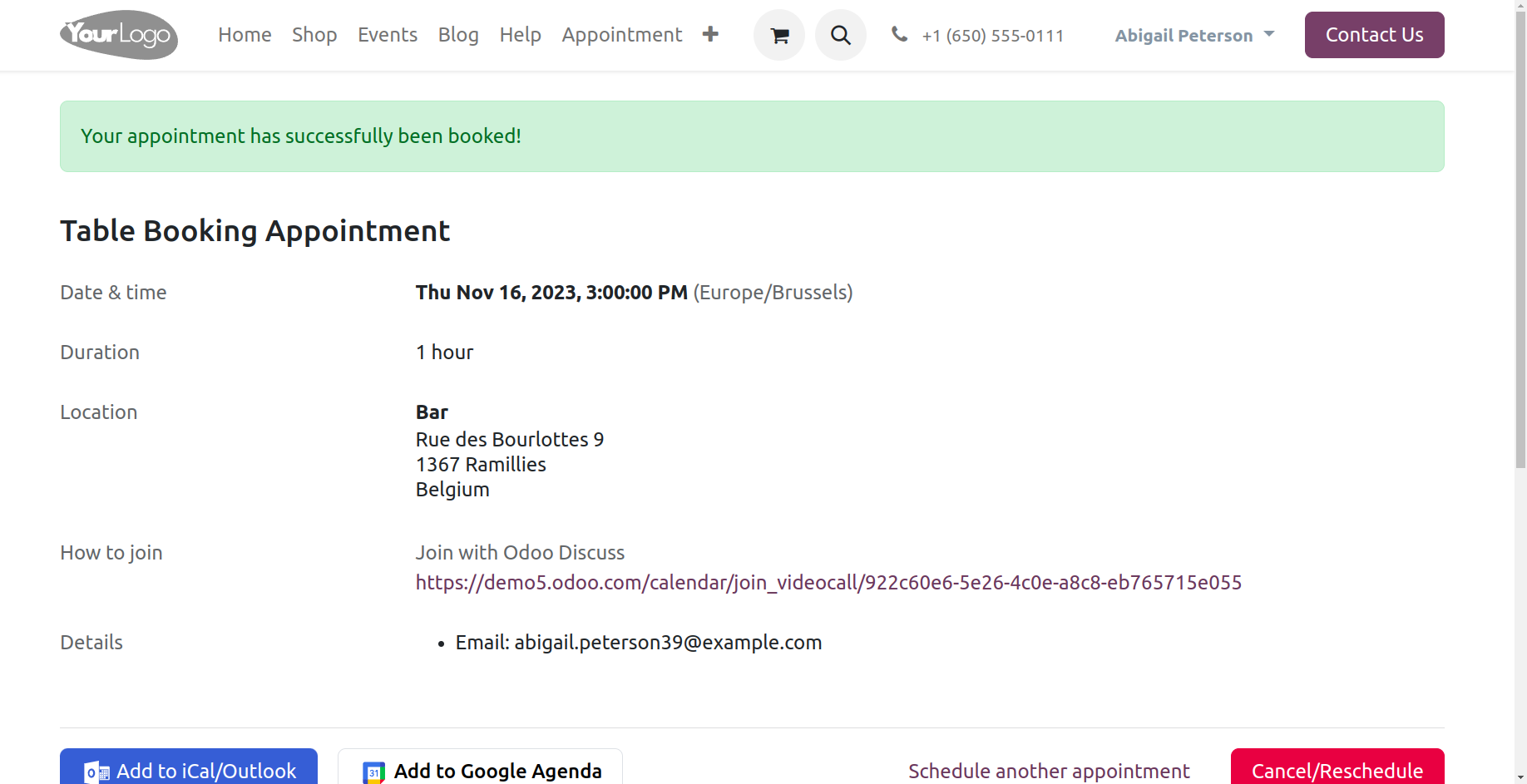
Once the session is open, you can see that one table has been
reserved via the website.
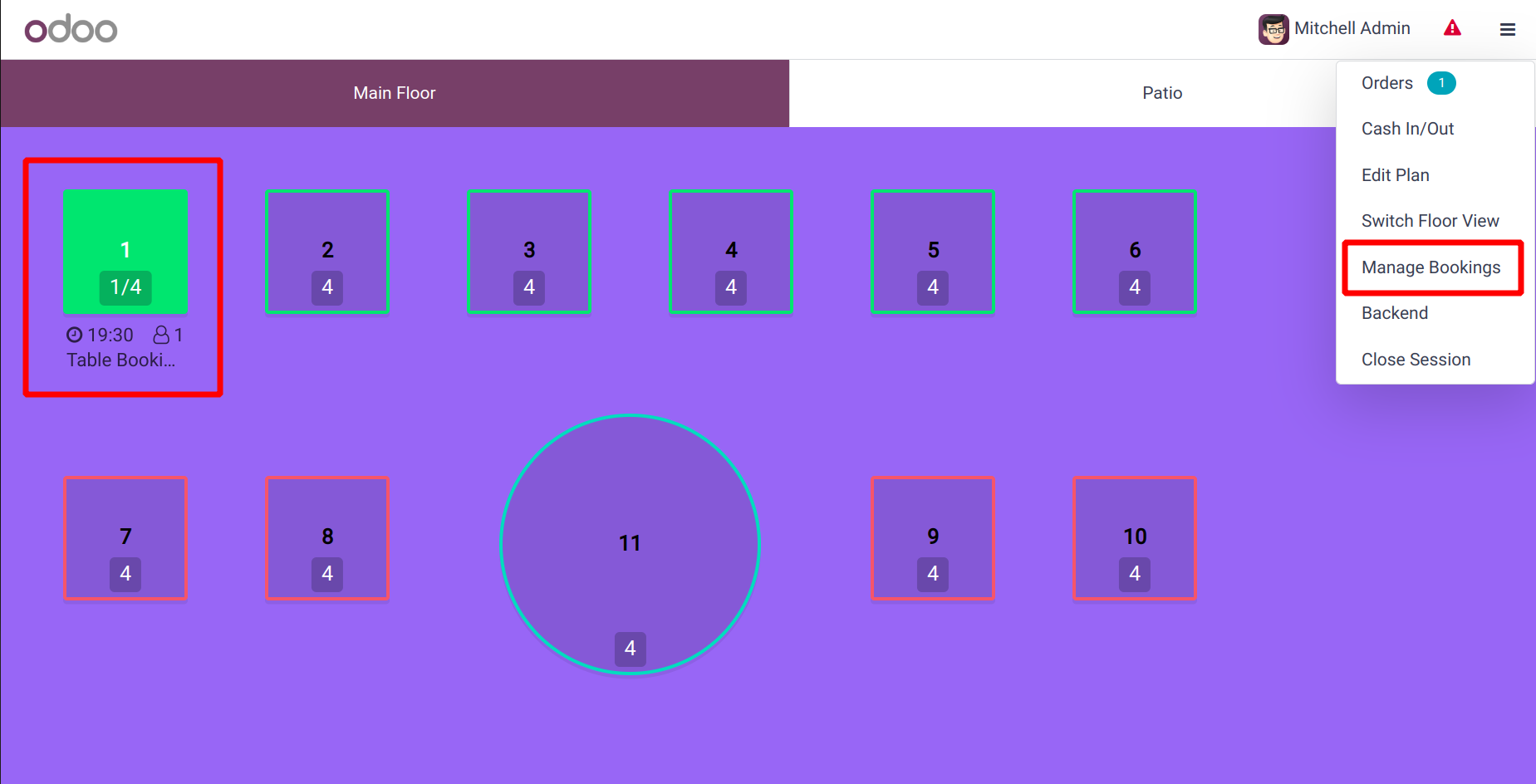
To change the appointment kinds, navigate from the Manage Booking
menu to the Appointment module.
Mobile self-order & Kiosk
The Mobile self-order and kiosk options come next. Which Odoo 17 has
just introduced. Customers can use a kiosk or their mobile device to
place orders by selecting this option.
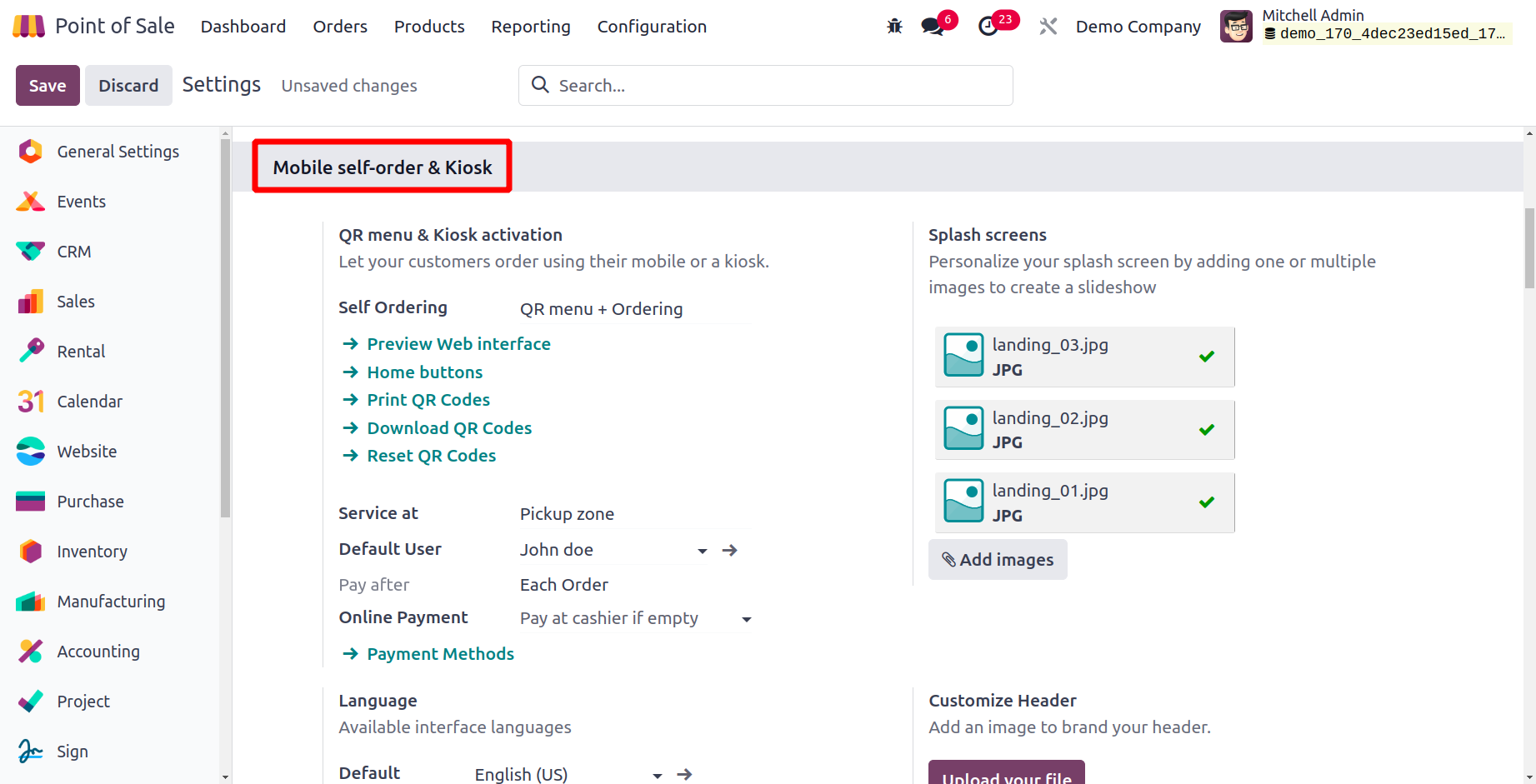
In this case, Self-ordering can be configured as a Kiosk, QR Menu, or
QR Menu+ Ordering. An overview Users can view a preview of the
webpage through the web interface. The generated preview button may
be viewed from the Home buttons option, and the New button allows
you to build a new one.

From there, you can print, download, or reset the QR Code. From
there, you may also set up other details like Pickup at, default
user, Languages, etc. Upload an image to Splash Screen to make it
uniquely yours.
Self Ordering is now enabled for this session after saving the
preferences. As shown in the screenshot, a Mobile Menu option will
appear.
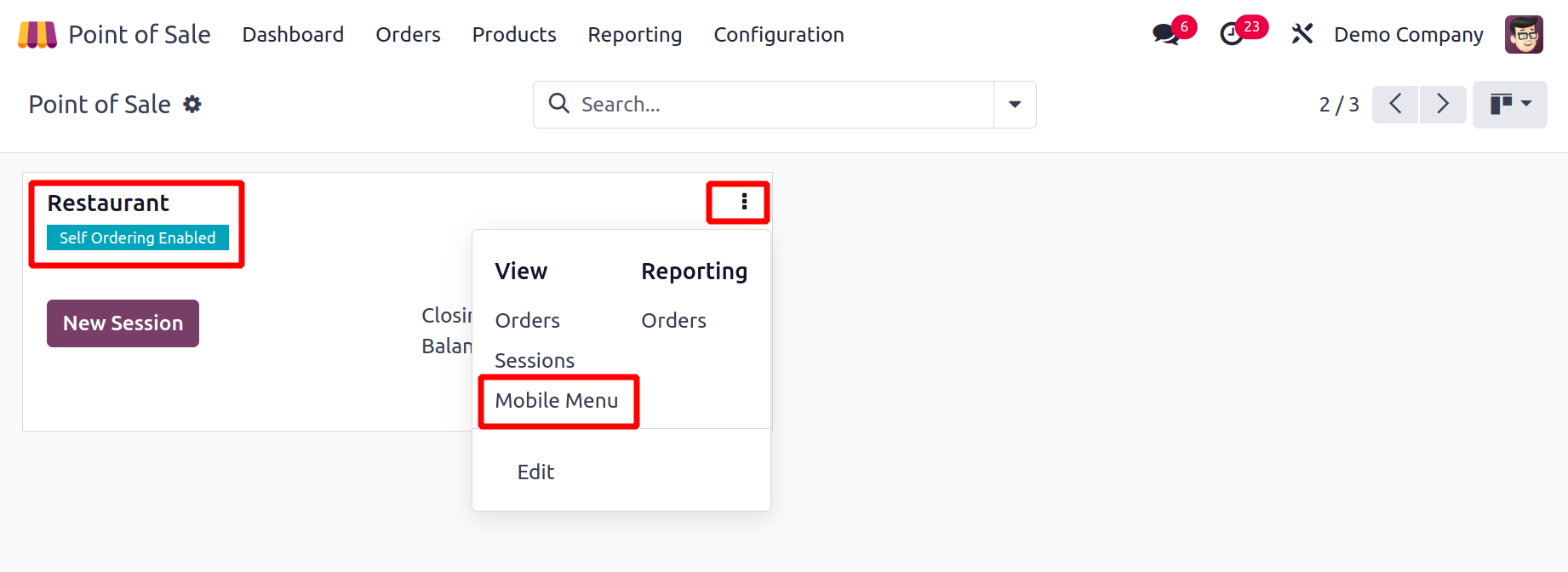
Selecting the Mobile Menu option opens a new screen. Customers can
then place their own orders from there. Click the "Order Now" button
to do that.
Here, orders can only be placed by clients when the session is open.
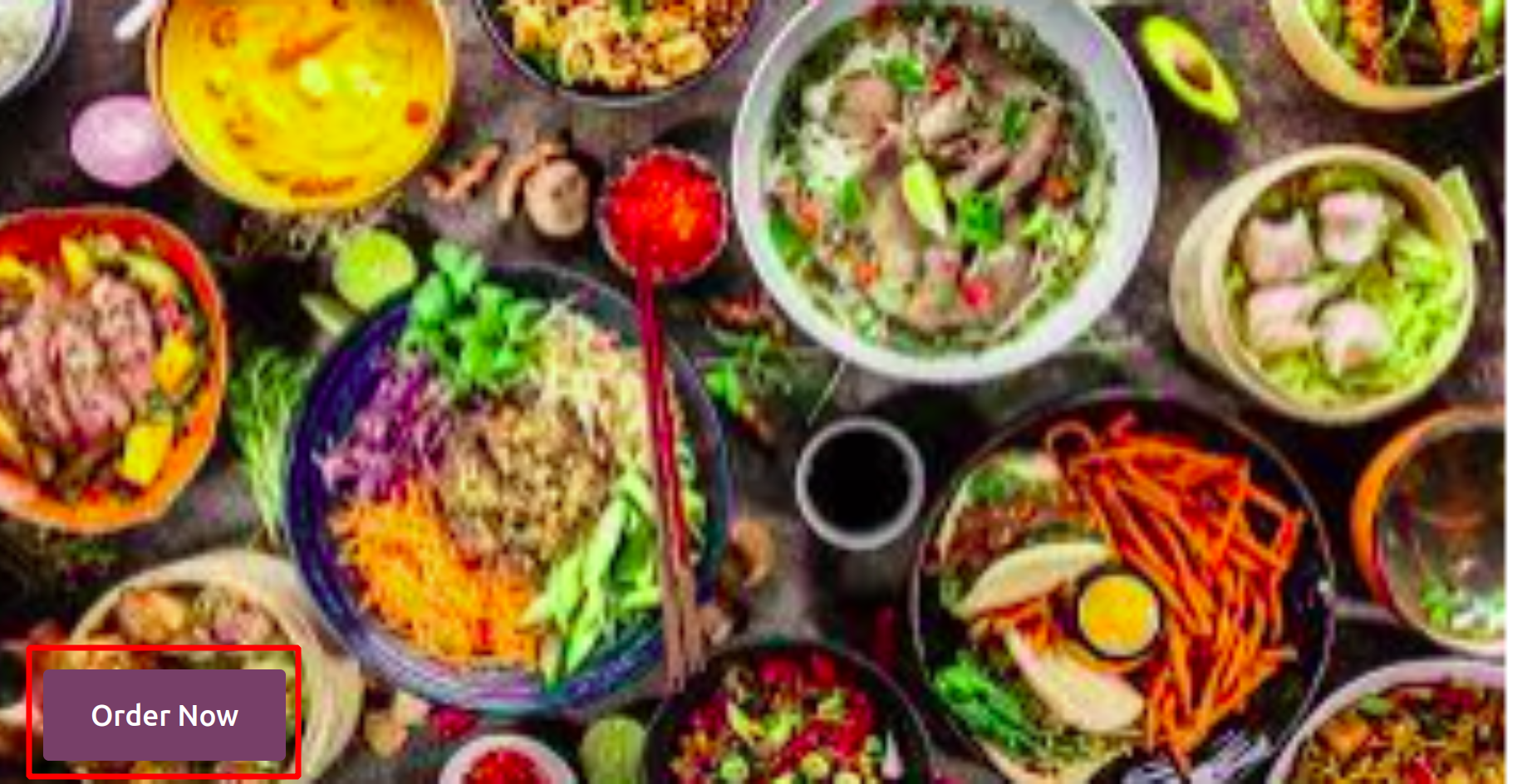
Click the Order button after selecting the desired product.
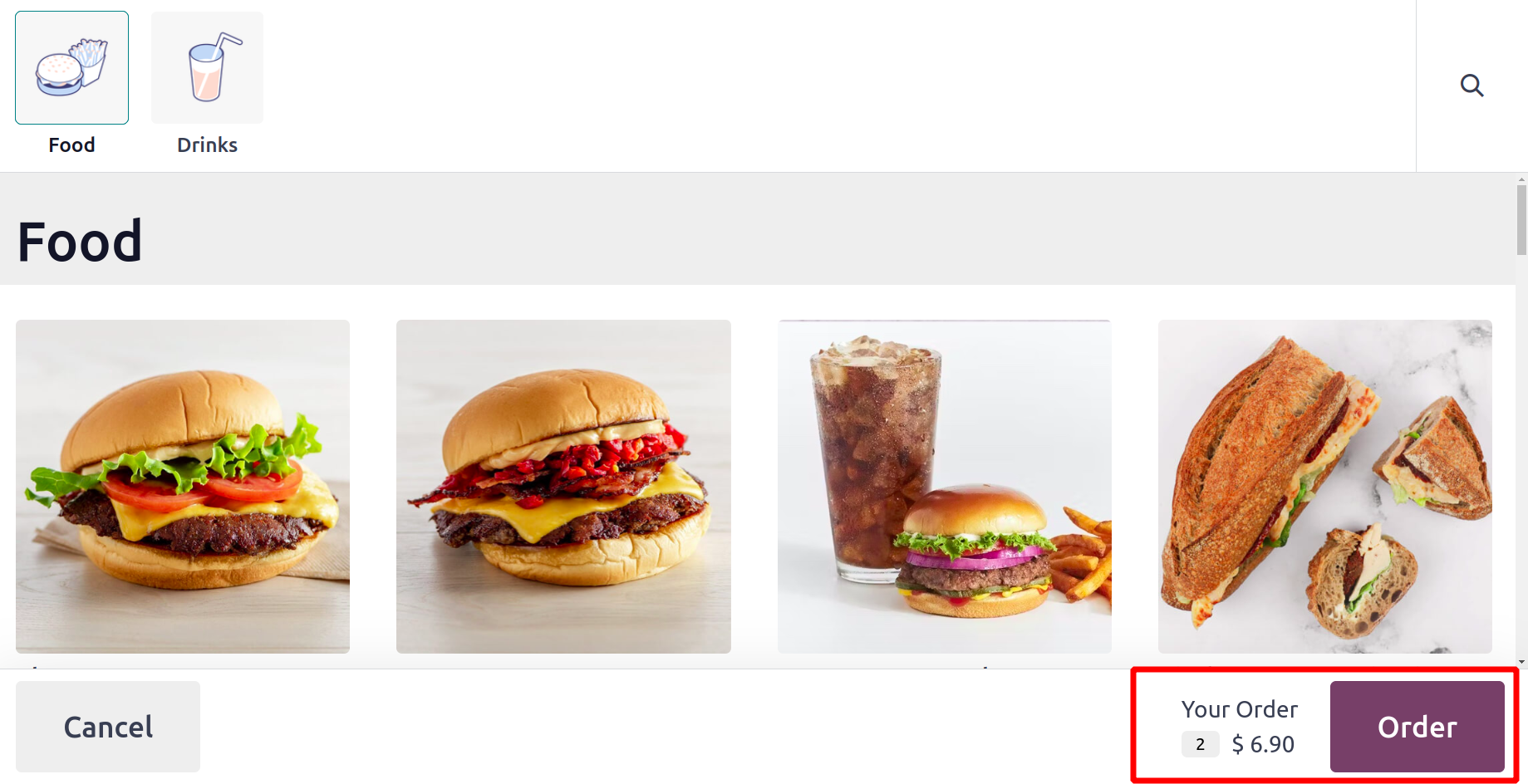
The client can then select Table.
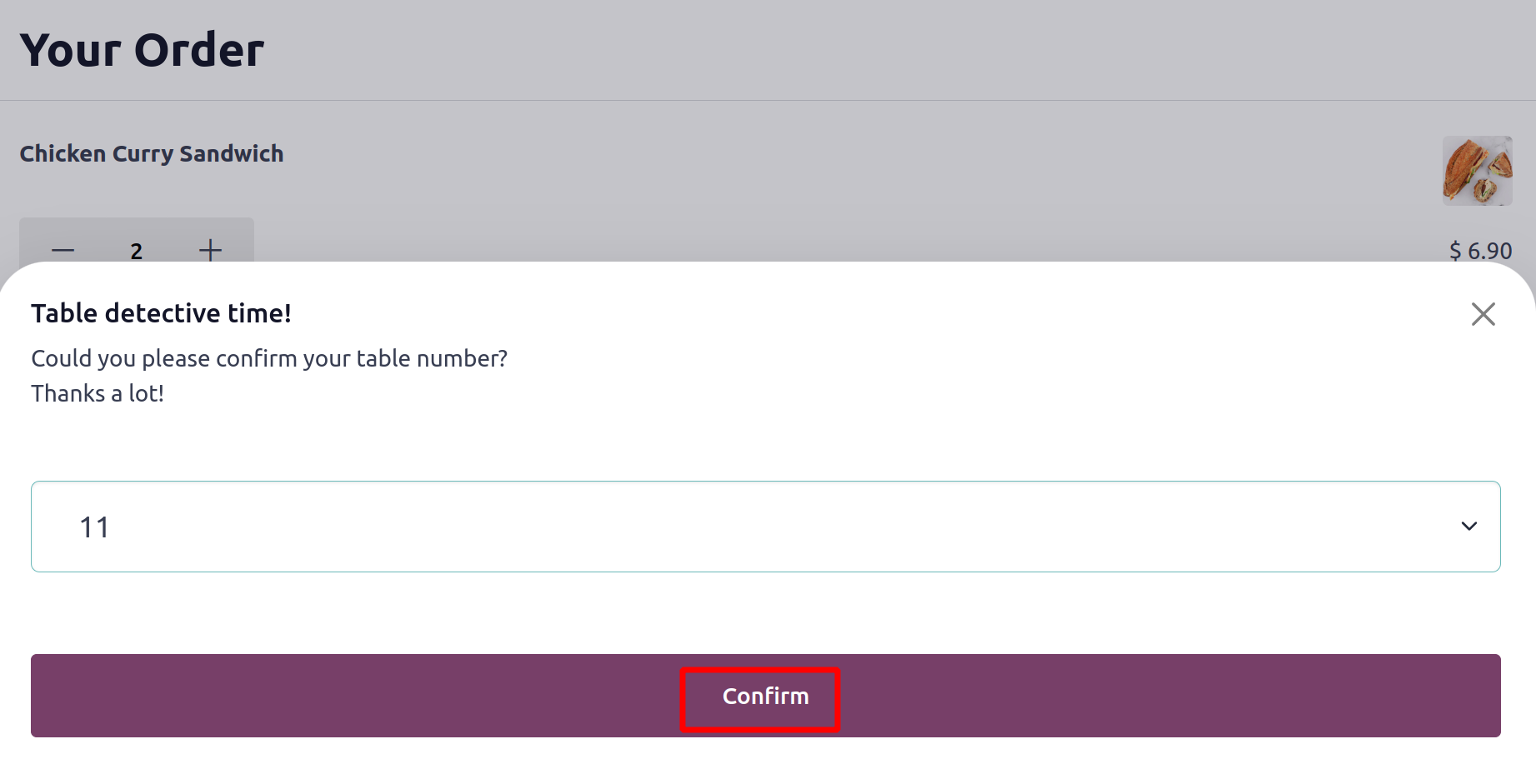
An order confirmation will be sent after it is verified.
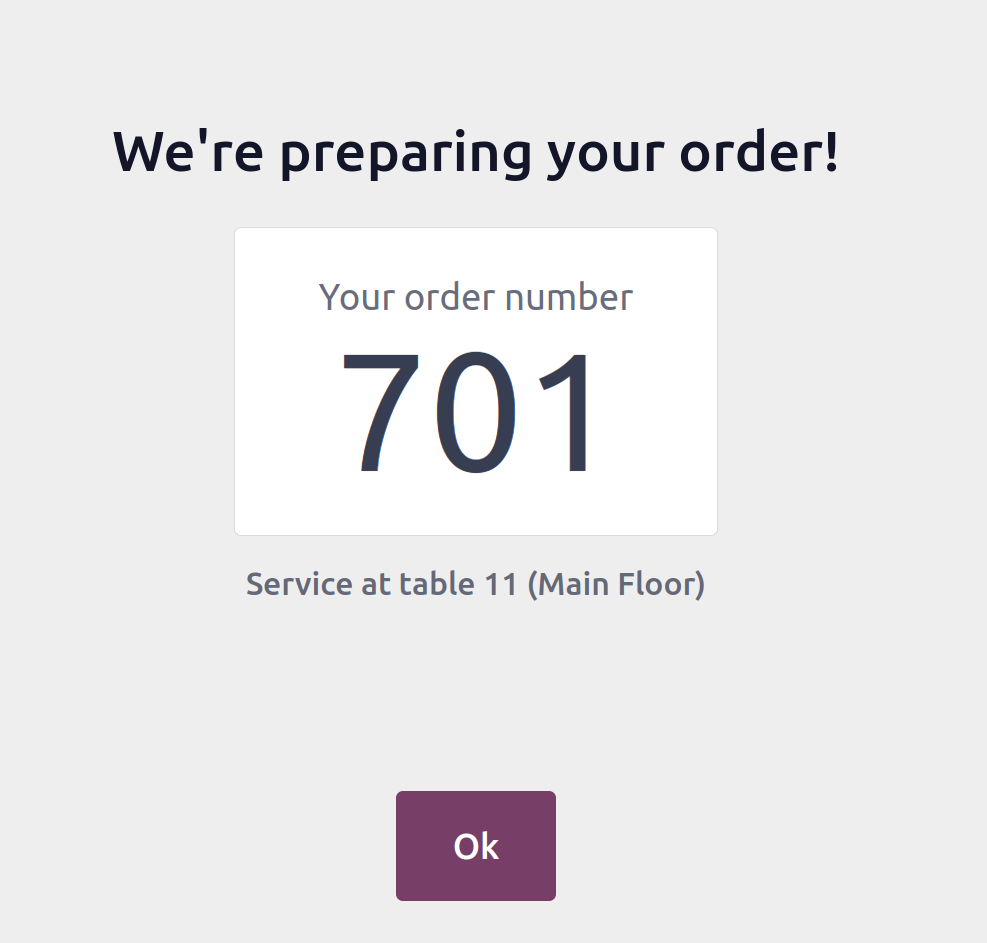
The order is then contained in the relevant Table inside the session.
From there, the user can finish the order.
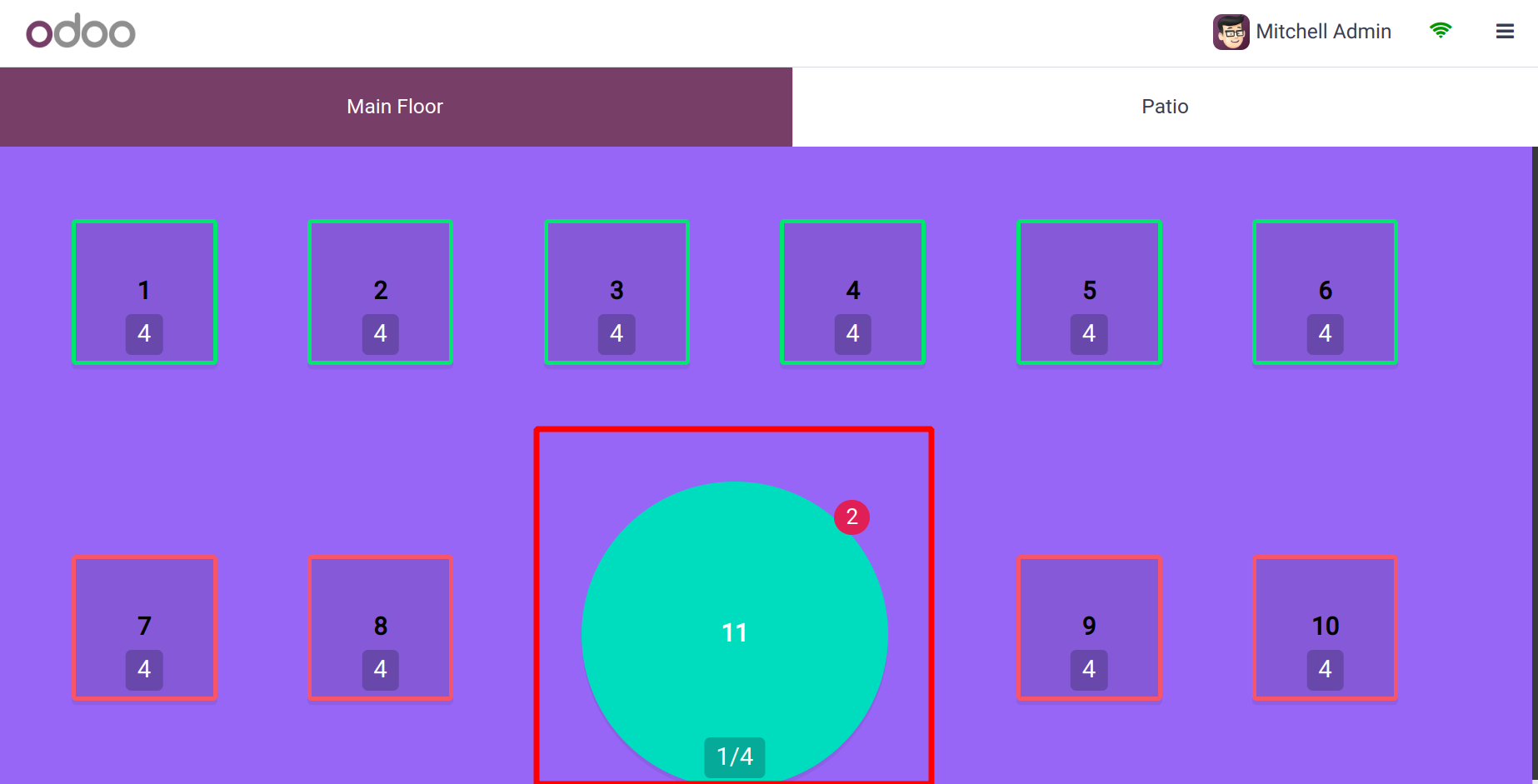
If the cashier is not present, clients can view their order and make
payment from the same mobile screen by selecting the My Order
button.
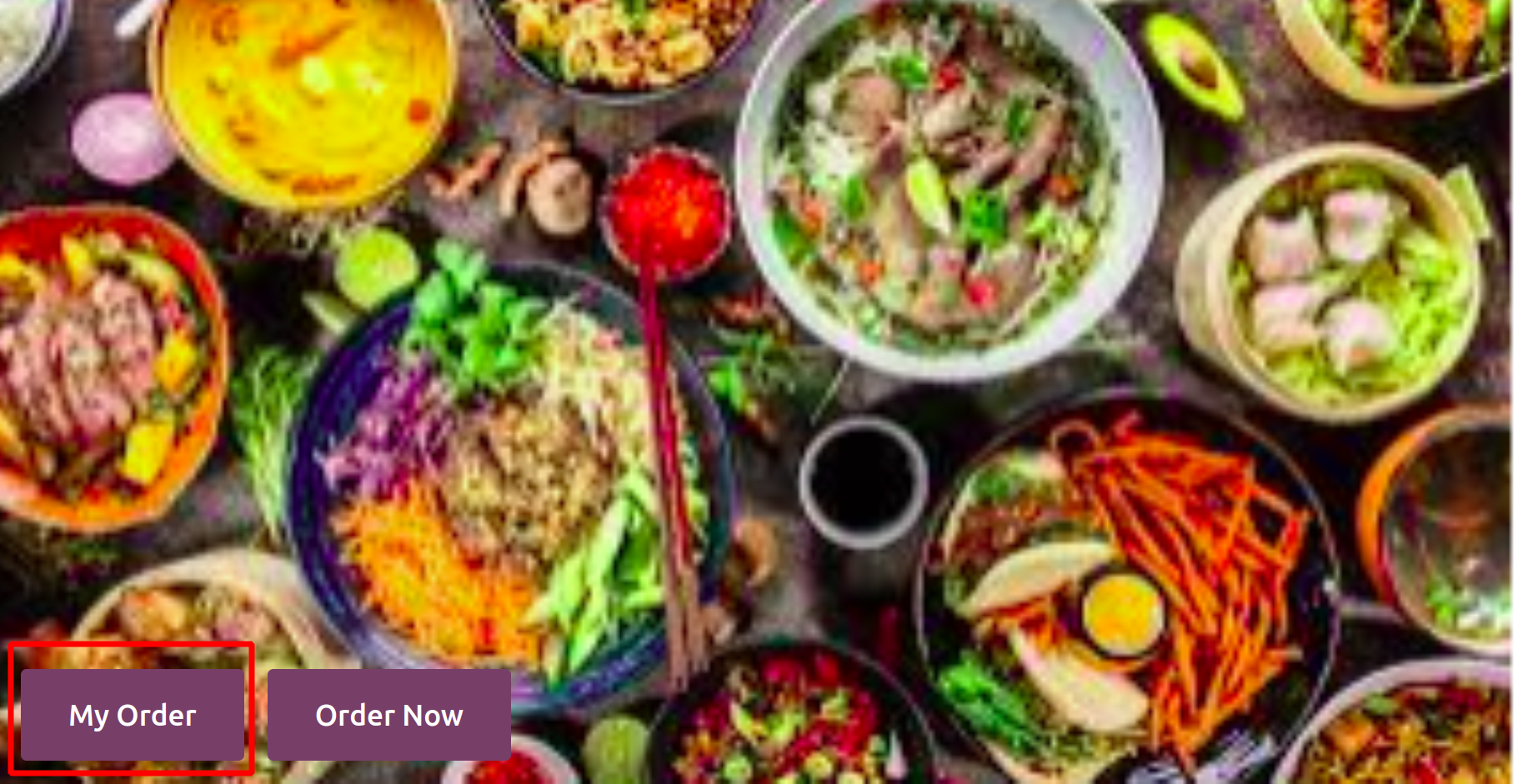
Save the settings once the Self-ordering is configured as a Kiosk.
The dashboard session will then display an Open Kiosk button.
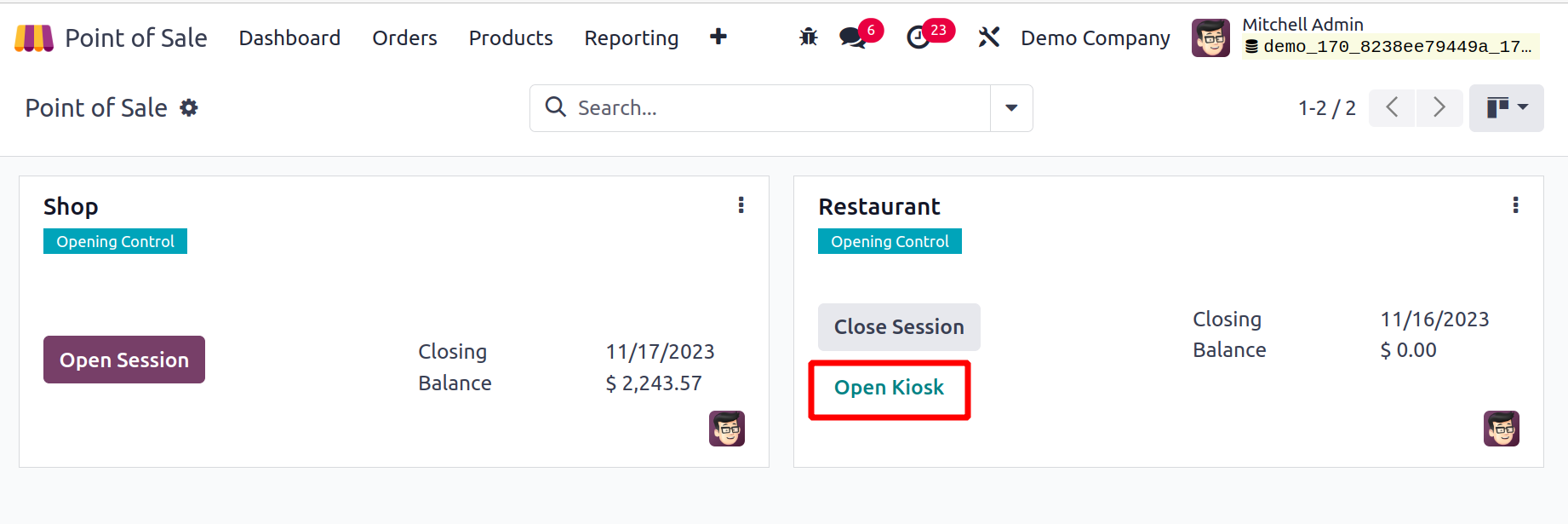
A Self Kiosk window with a URL will open when you click on it. Click
the "Open in new Tab" button to open it in a new tab.

Following that, a self-ordering window will open, allowing clients to
place orders.
Eat-in/Take-out allows the tax rate to be adjusted according to
whether customers choose to eat in or order takeaway. Thus, include
a fiscal position in the relevant field.
Payment
The Payment Method field allows users to choose the payment options
offered by this PoS. By turning on the Cash Rounding option, you can
specify the smallest denomination of the currency that is used to
make cash payments. Use the Tips option to accept customer tips or
alter their change into a tip. Enter the Tip Product in the
appropriate field. This information appears on customer receipts as
a reference.
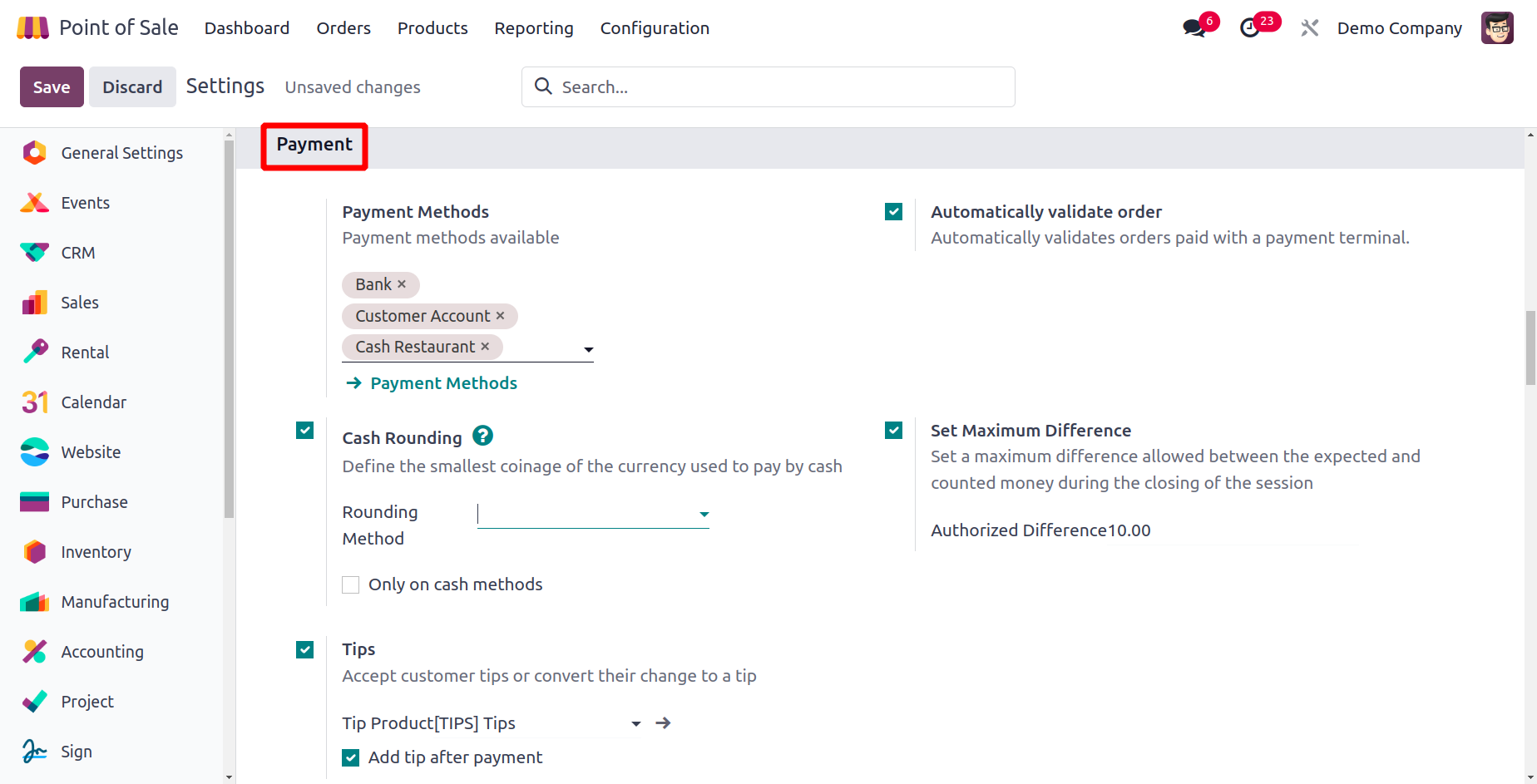
You can set a maximum difference between the expected and counted
money during the session ending by turning on the Set Maximum
Difference field. The Authorized Difference parameter allows the
permissible difference to be specified.
With Automatically Validate orders, orders paid for through the
payment terminal can be automatically validated.
PoS Interface
You can enable the Large Scrollbars option to enhance navigation on
sluggish industrial touchscreens. Using the Restrict Categories
function, you can also limit certain product categories.
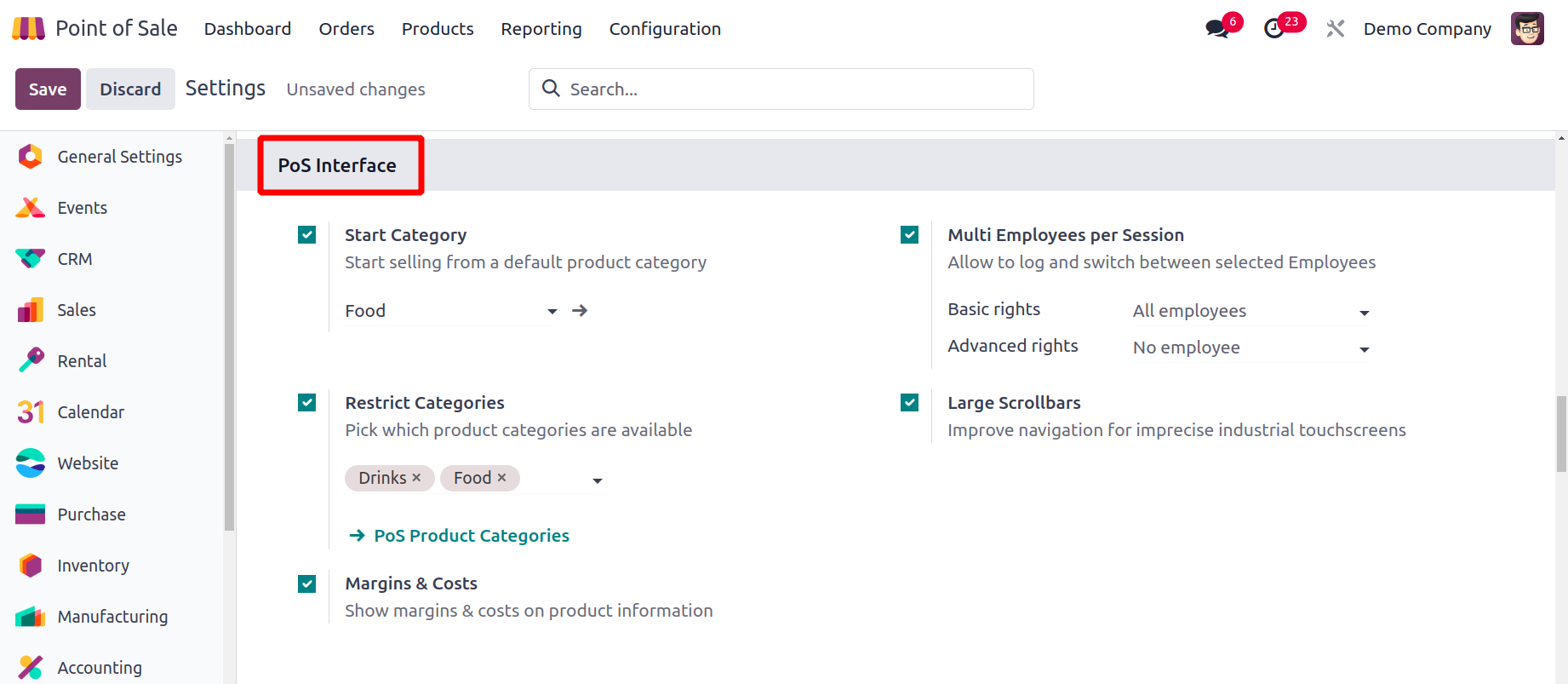
After enabling the Start Category option, you can begin selling
products from a default product category by mentioning it in the
provided space. As an illustration, make the Start Category the
product category Chair. Following the beginning of the relevant
session, the Chair product category will come up by default to
begin the sale on the point-of-sale dashboard, as illustrated below.
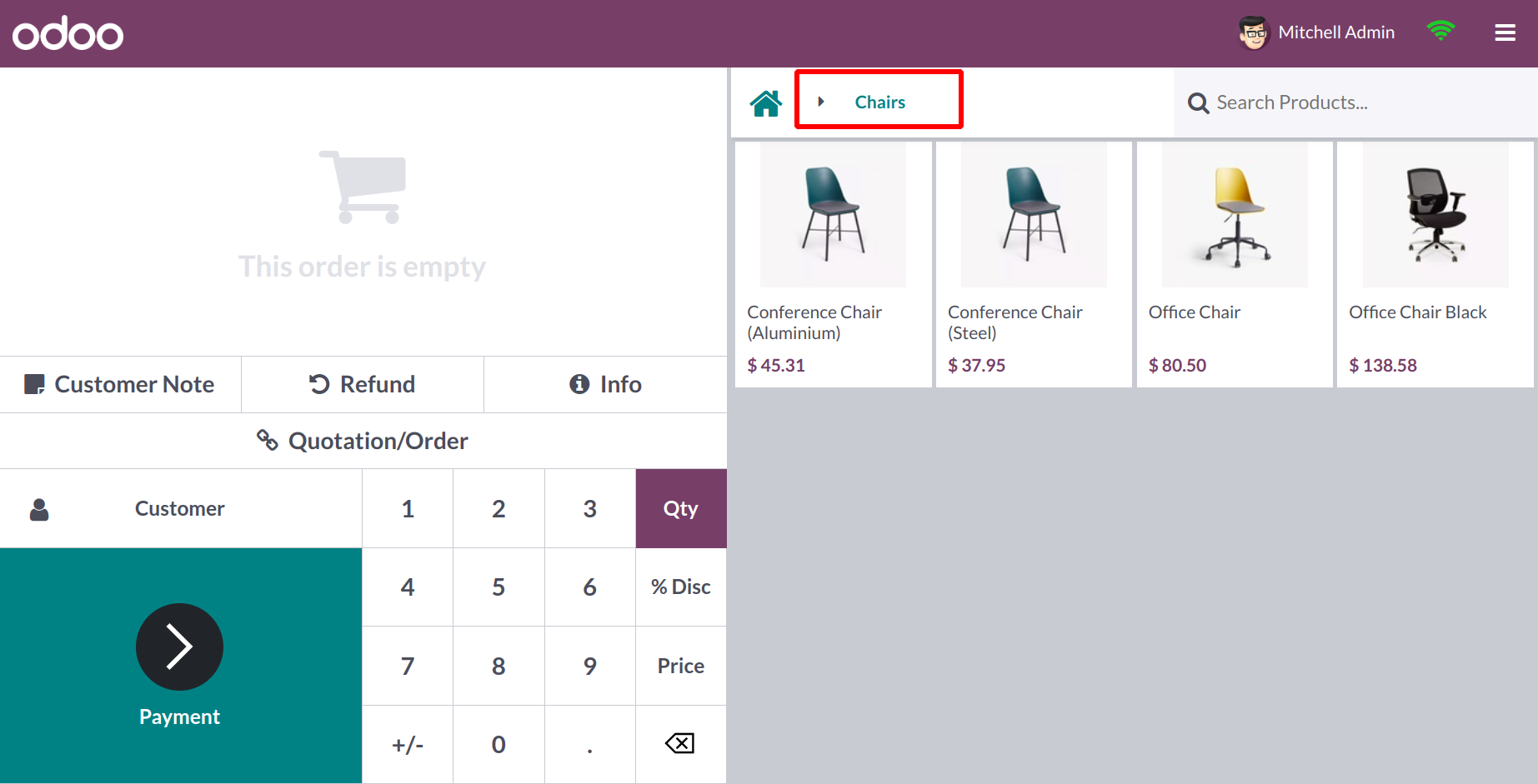
When the Margins & Costs option is activated, product information in
POS will display margins and costs.
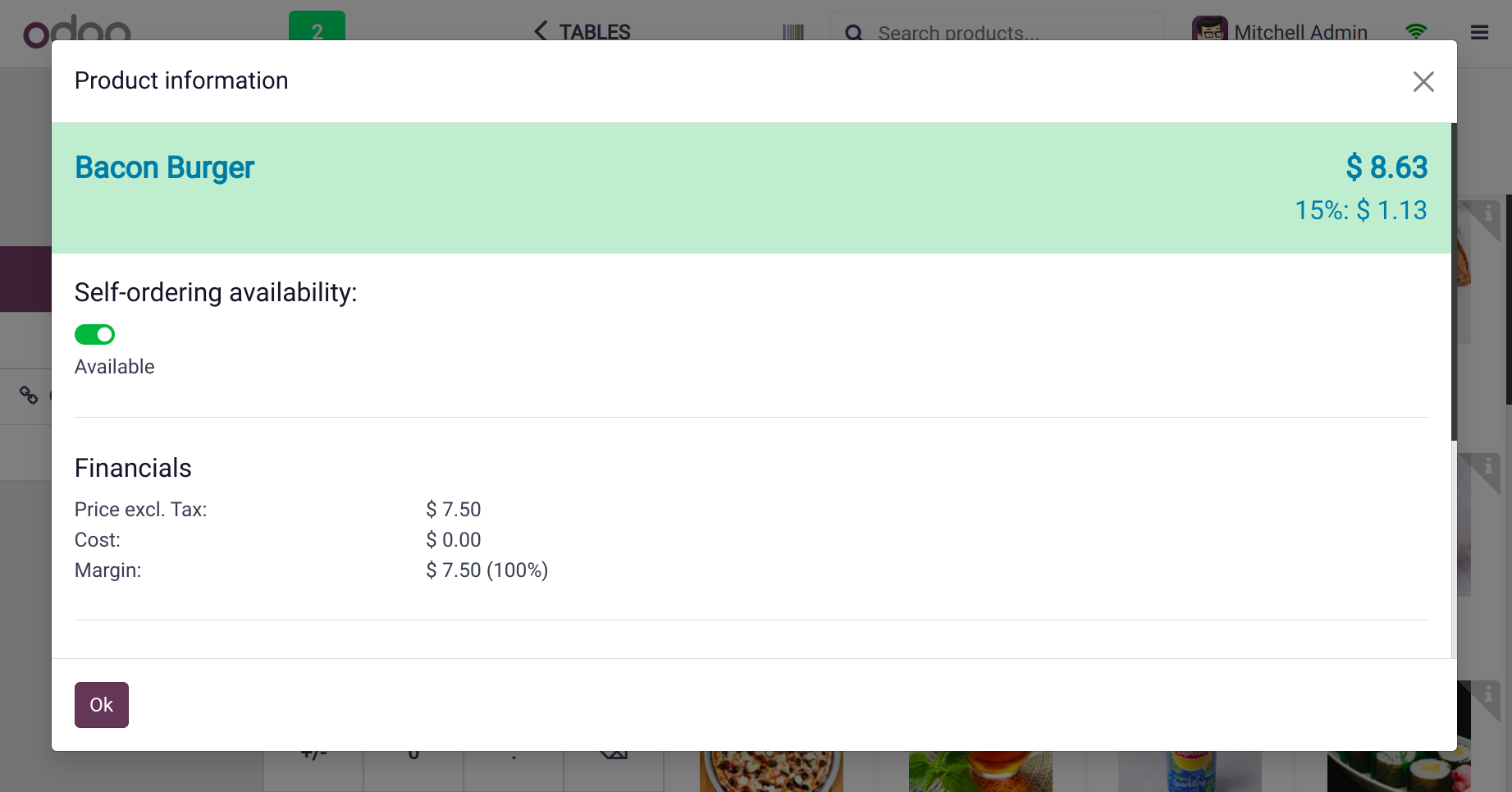
Multiple employees can access the PoS session if the "Multi employee" option is activated. Include authorized workers.
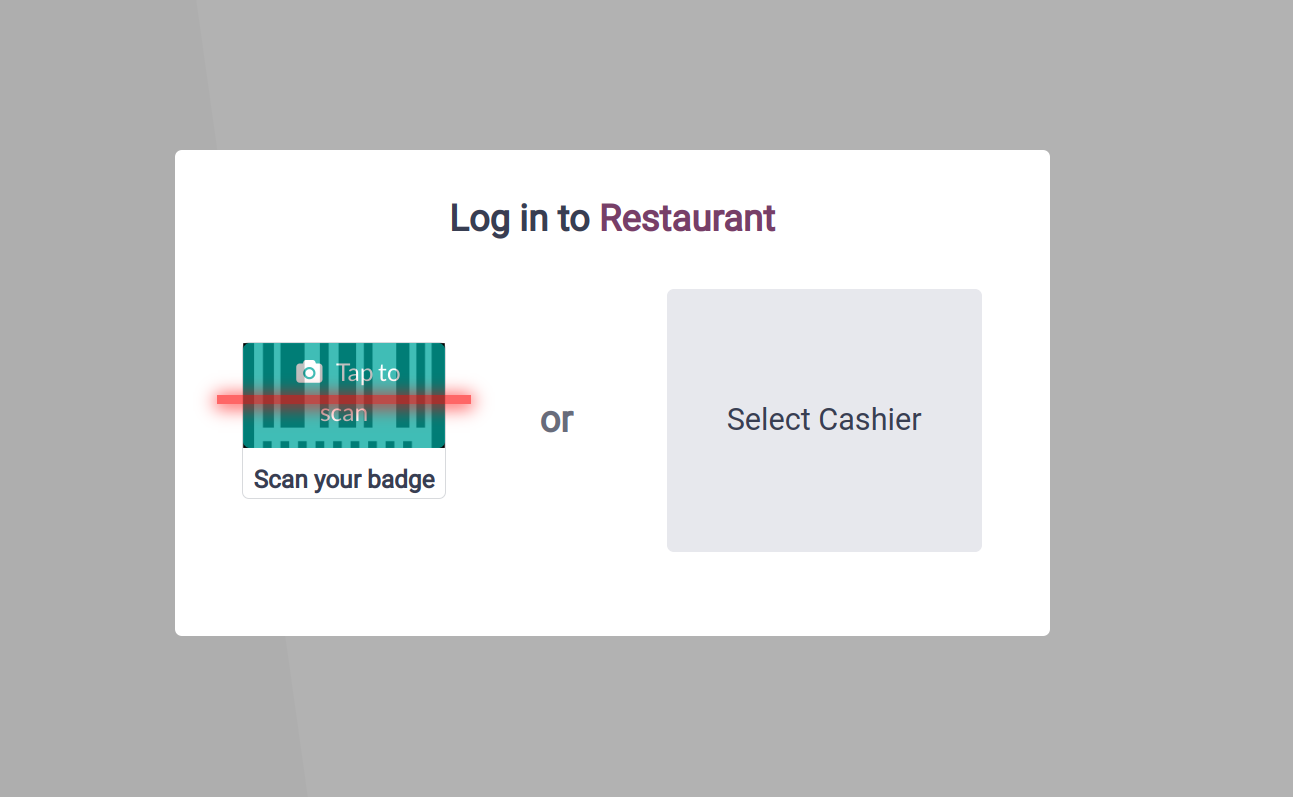
After that, the relevant staff members can use their credentials to log into the session.
Accounting
The Accounting tab allows you to choose the Default Sales Tax for
the items in the PoS. Any new items added to the catalog are subject
to this sales tax. Use the external
link provided on this page to manage the available sales taxes.
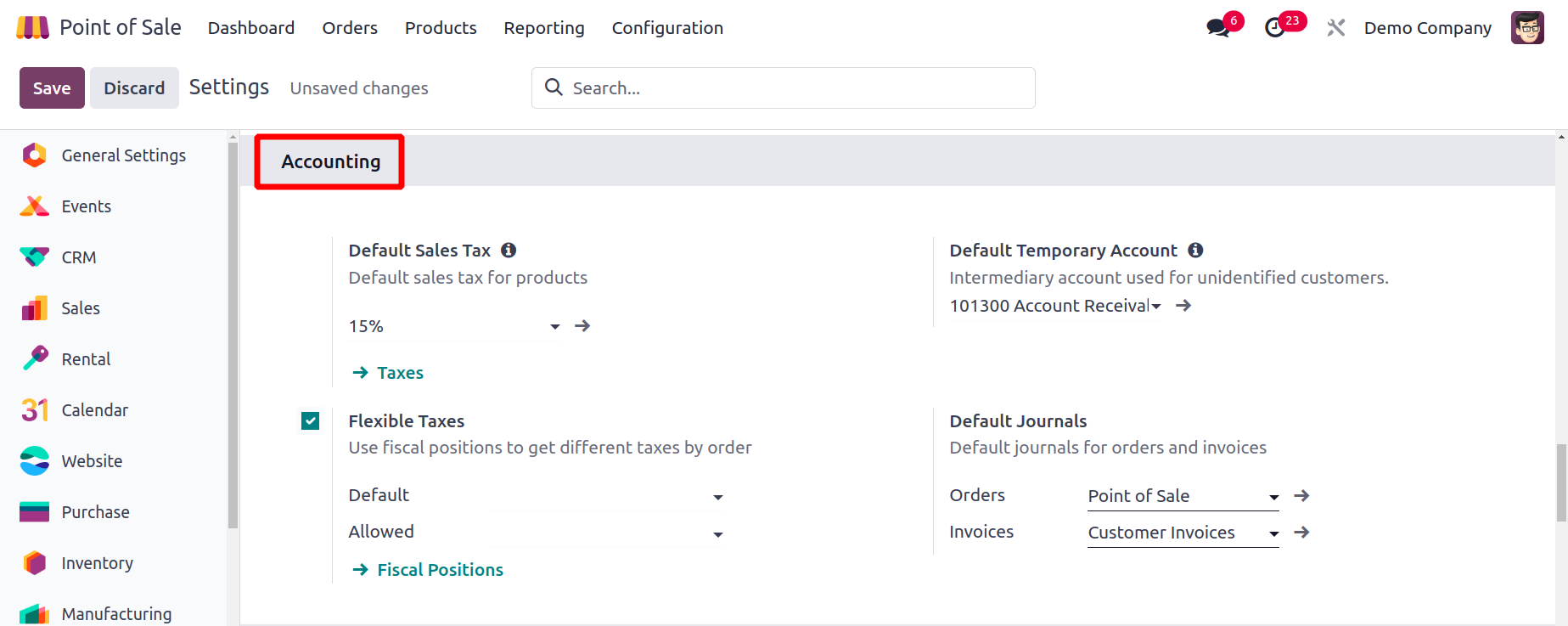
Depending on the type of customer, choosing a specific fiscal
position at the order is made possible by activating the Flexible
Taxes. You can define the intermediary account used for unidentified
clients in the Default Temporary Account section. The Default
Journals feature allows users to specify the default
journal that will be used for orders and invoicing.
Sales
You can designate a sales team for this new PoS under
the Sales page, and the sales will be reported to that Sales Team.

You can specify a product in the "Down Payment Product" area, and
when a down payment is made,
this product will be used.
Pricing
You can choose the price lists used for the products in this PoS by
turning on the Flexible Price Lists feature in Odoo17. It can either
be based on Advanced price rules or Multiple prices per product. In
the designated spaces, the default and accessible price lists can be
entered. There are two options for the Product Prices on
the receipts: Tax-Excluded Price and Tax-Included Price.
The price of a good or service before taxes are deducted is shown in
the Tax-Excluded Price, whereas the price that includes all relevant
taxes is known as the Tax-Included Price. In essence, the
tax-included pricing shows the total amount a customer pays,
including taxes,
while the tax-excluded price is the basic amount.
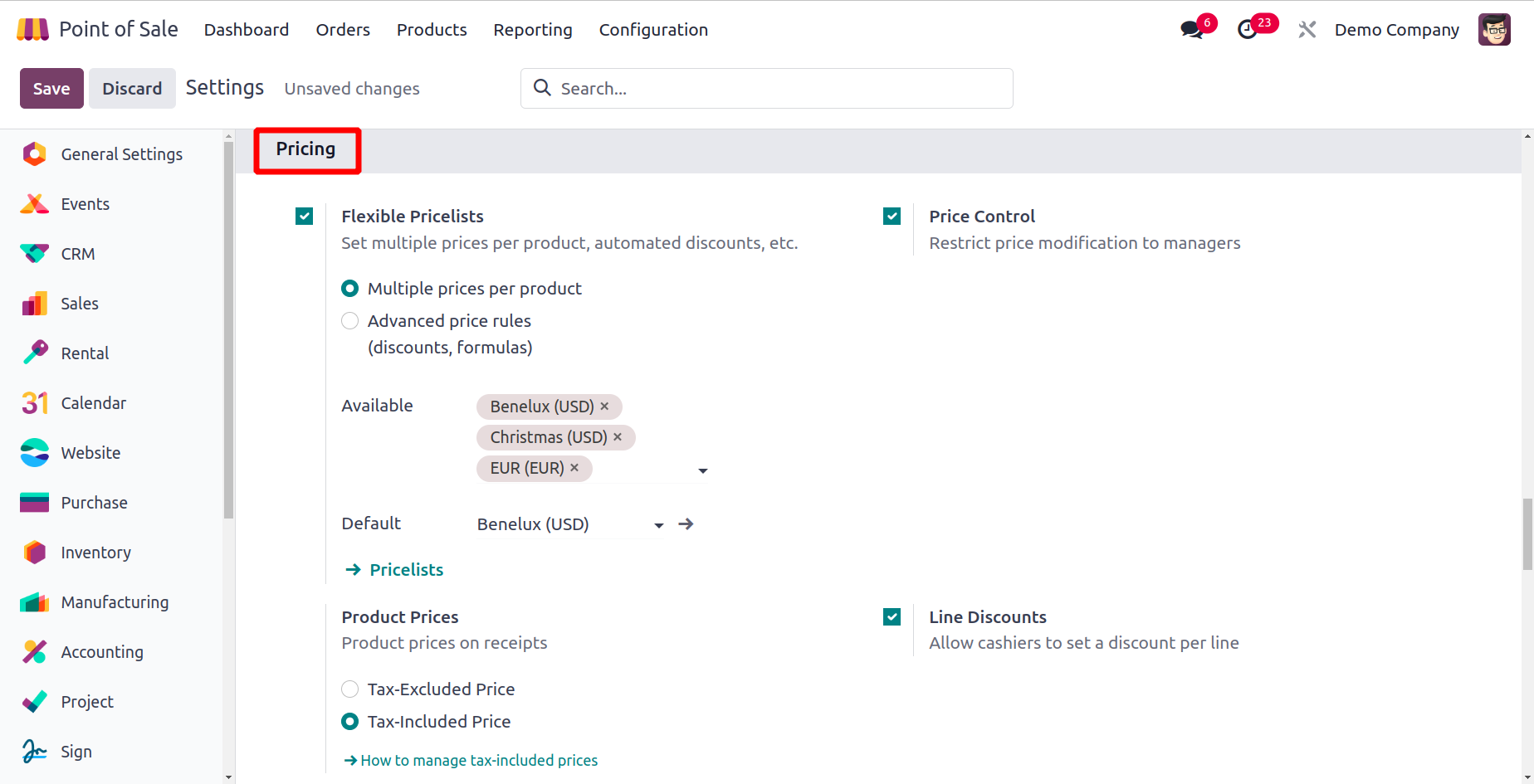
By turning on the Price Control option, you can only allow the
manager to change prices. By doing this, the product pricing on
orders can only be changed by users having Manager access rights for
the PoS app.

After activating the Line
Discount option, Odoo 17 will let cashiers set a discount per line.
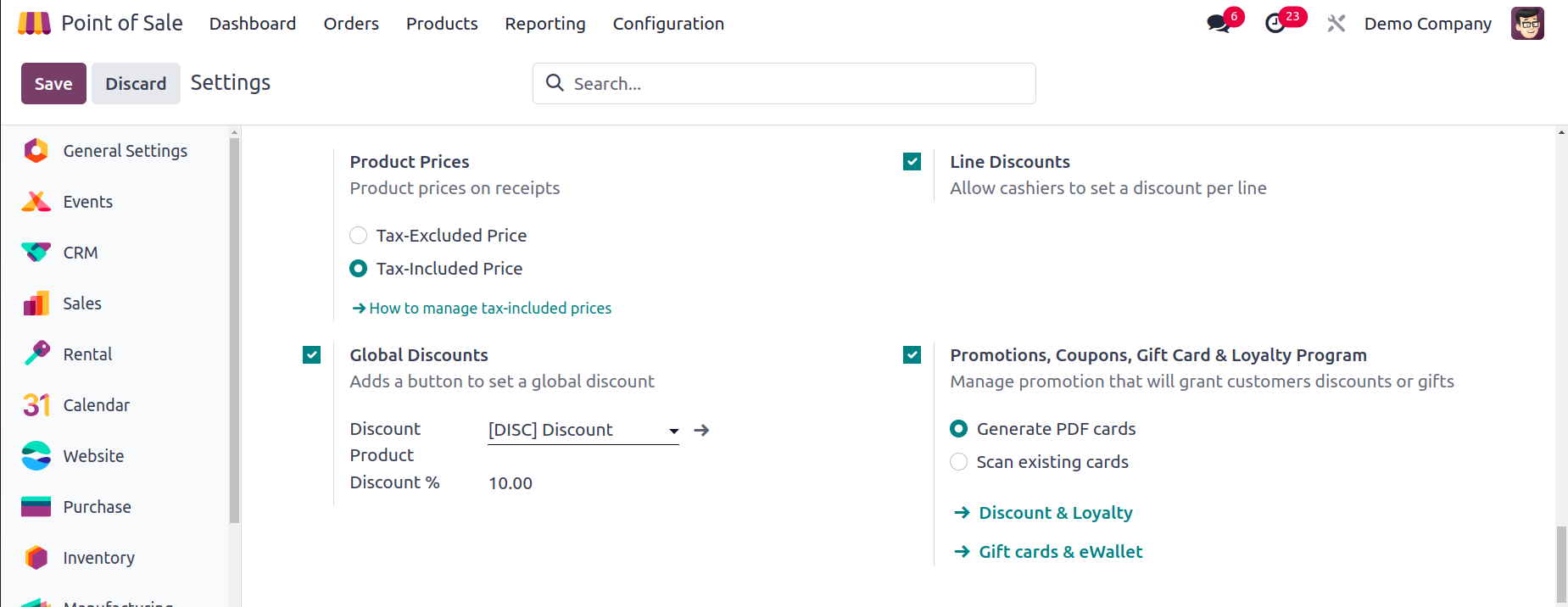
By turning on the Global Discounts functionality, you can add a
button to establish a global discount on products. In the fields
provided, you can note the discounted product and the discounted
percentage.
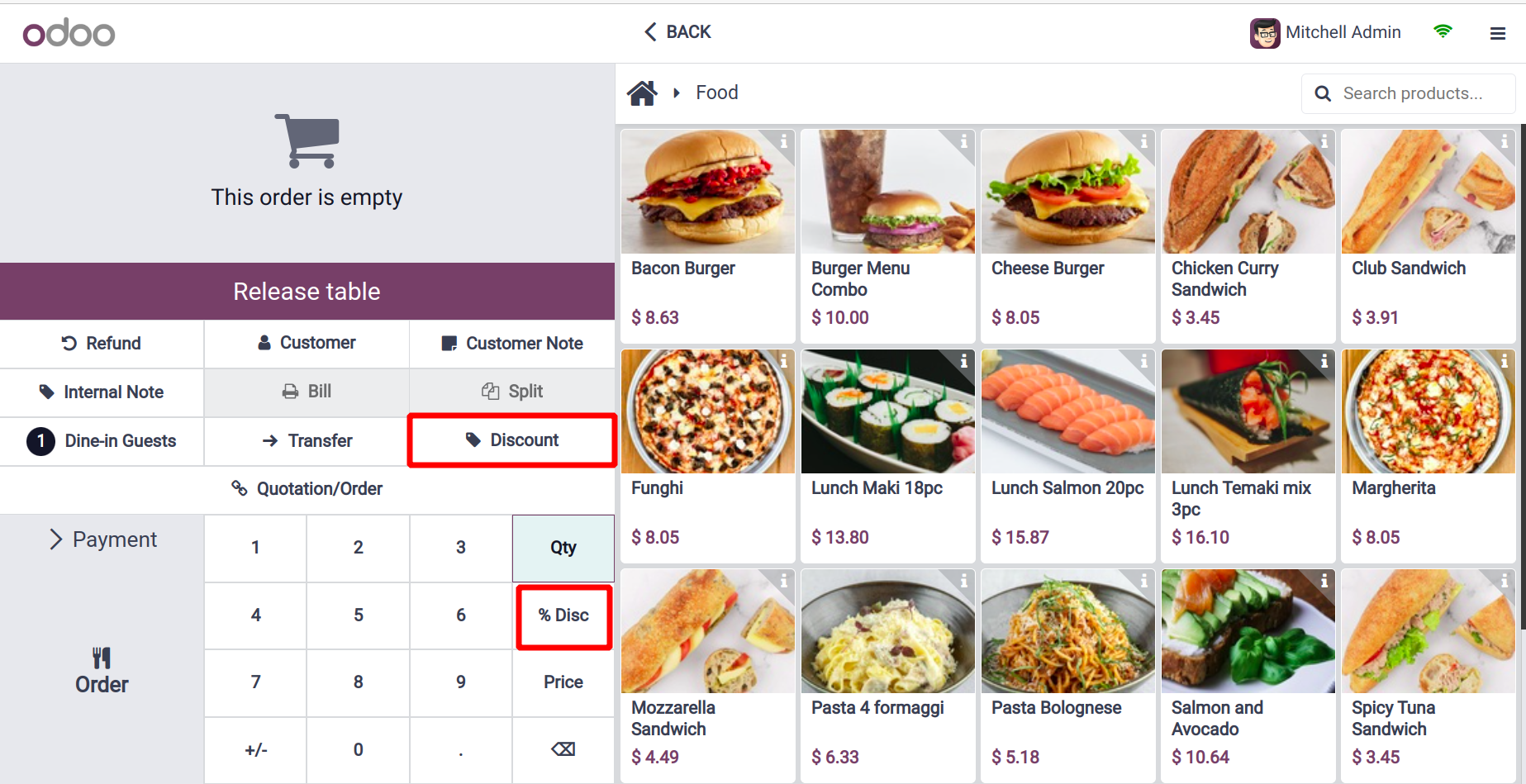
By making your consumer's various offers, you can increase your
sales. The Promotion, Coupons, Gift
Cards & Loyalty Programme button can be turned on for this.
Bills & Receipts
Activate the Custom Header & Footer feature to add a personalized
message to the header and footer of the invoices and receipts. To
specify the notes you want on the header and footer of the receipts
and bills, you will receive additional fields. Once the payment has
been registered, the Automatic Receipt
Printing feature enables you to generate receipts automatically.
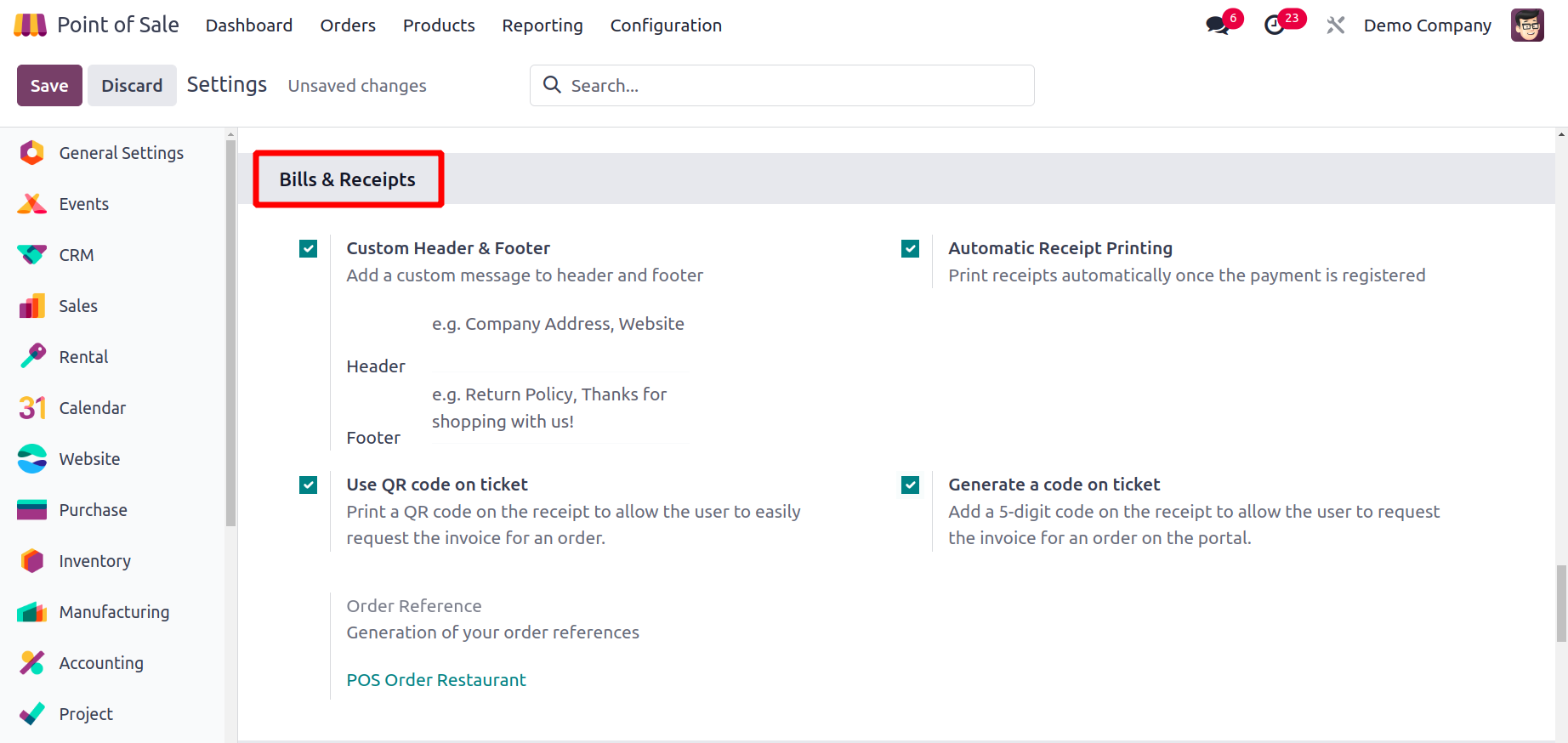
When the Use QR Code on Ticket option is turned on, a QR code will be
printed on the receipt, enabling the user to quickly retrieve an
order's invoice. As you enable the user to request the invoice for
an order on the portal,
Generate a code on the ticket that adds a 5-digit code to the
receipt.
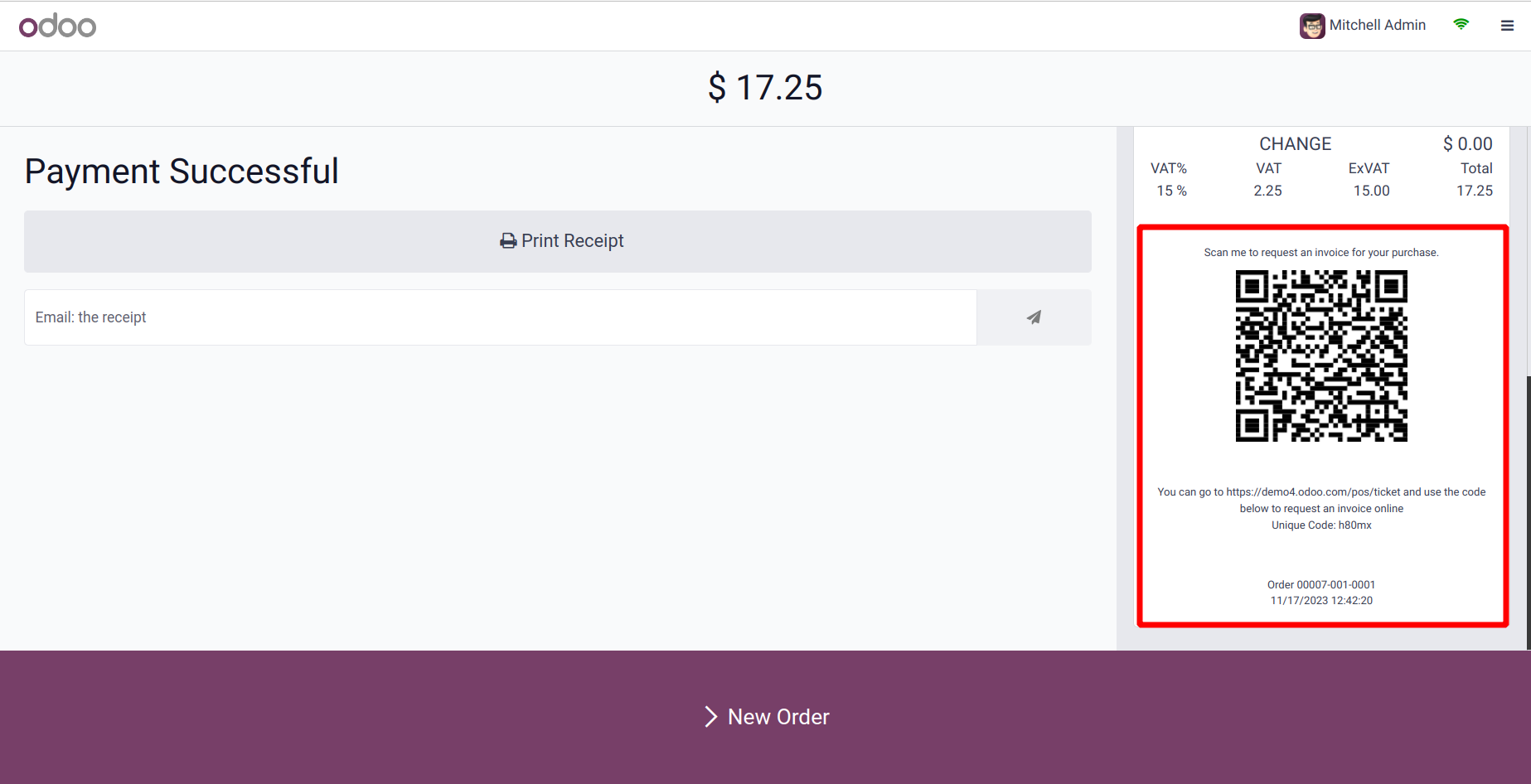
There is a link with the 5 digit code, using that particular link the customers can request the invoice.

Payment Terminals
Under the Payment Terminals page, you can view the available payment
terminals in the Odoo17. Point of Sale module. From here,
you may activate the appropriate payment terminals for your new PoS.
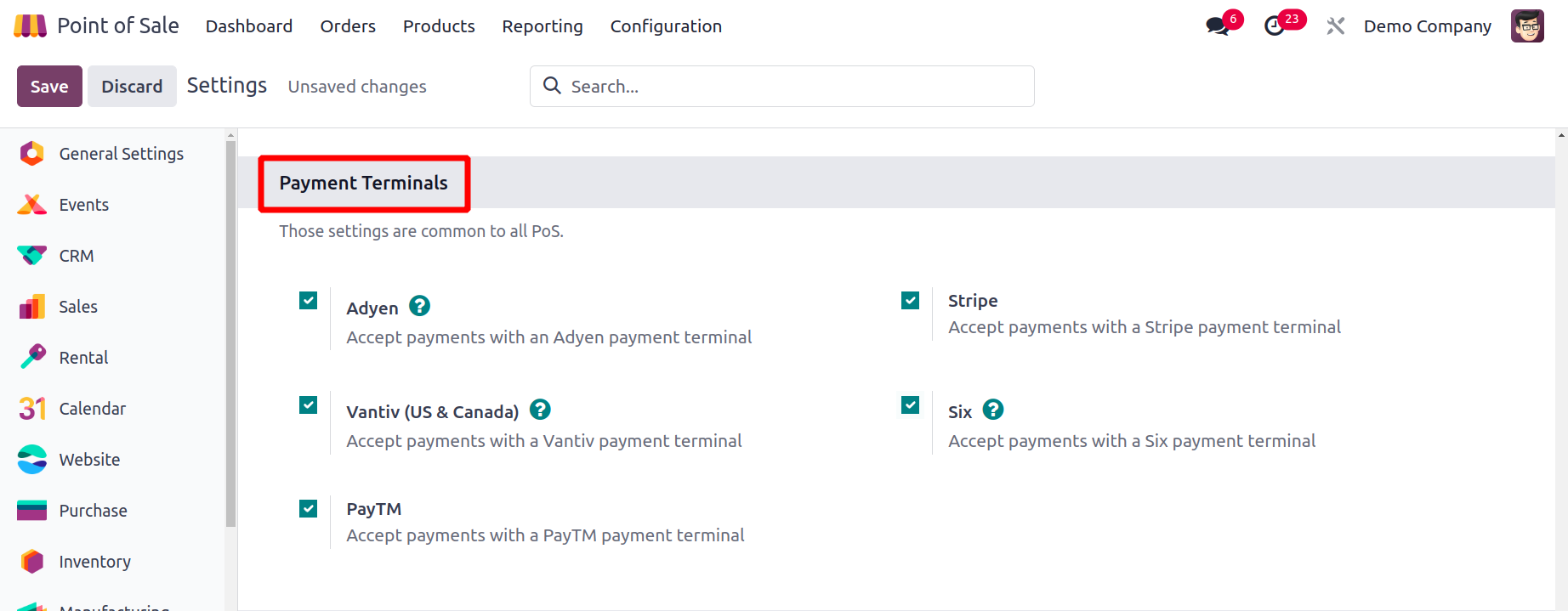
Depending on the option you select here, Odoo enables you to accept
payments through payment terminals from Adyen, Vantiv (US & Canada),
Ingenico (BENELUX), Stripe, Six, and Worldline.
Connected Devices
Devices can be connected to the PoS in Odoo without the need for an
IoT Box. Turn on the ePos Printers option in order to add printers.
While the consumer is checking out, they show them an additional
display and activate the Customer Display feature. You can add a
custom background image by uploading an image through these options.
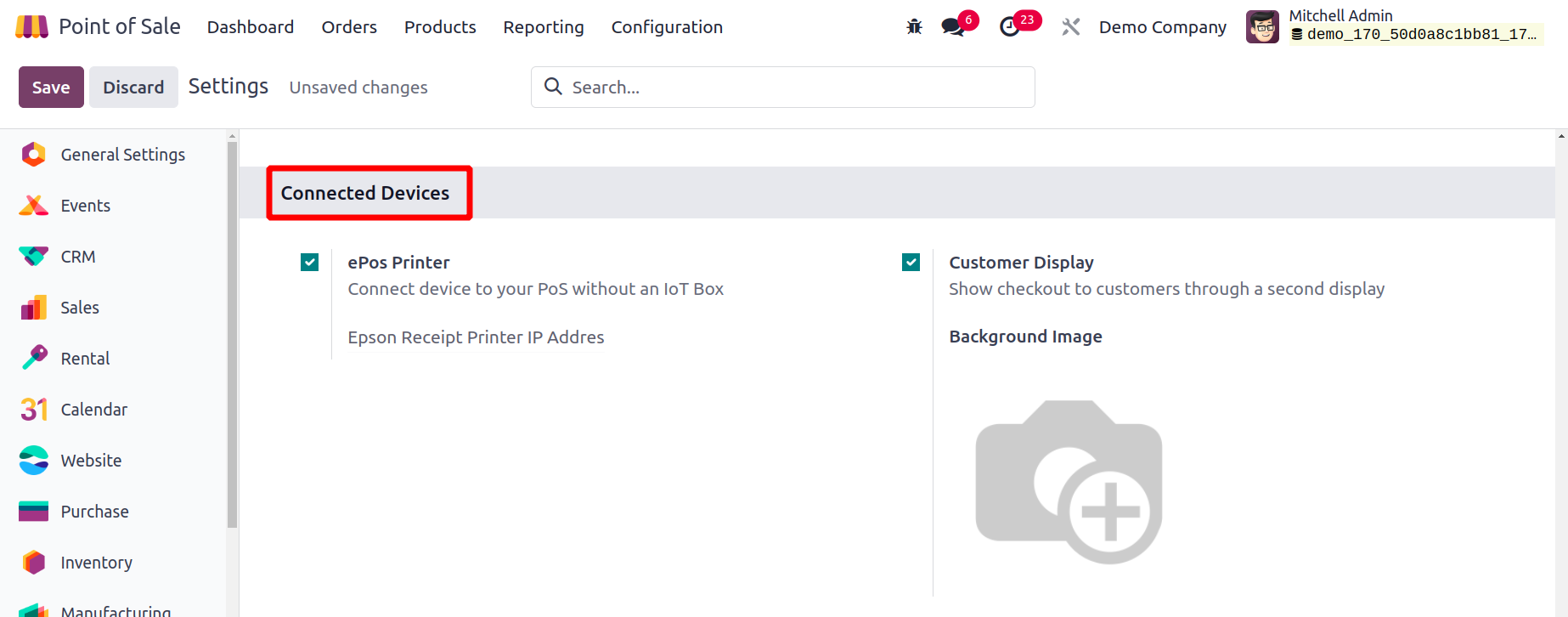
Users are able to connect gadgets with the IoT Box box. You can add a
barcode scanner/card reader, electronic scale,
customer display, receipt printer, and more inside the settings.
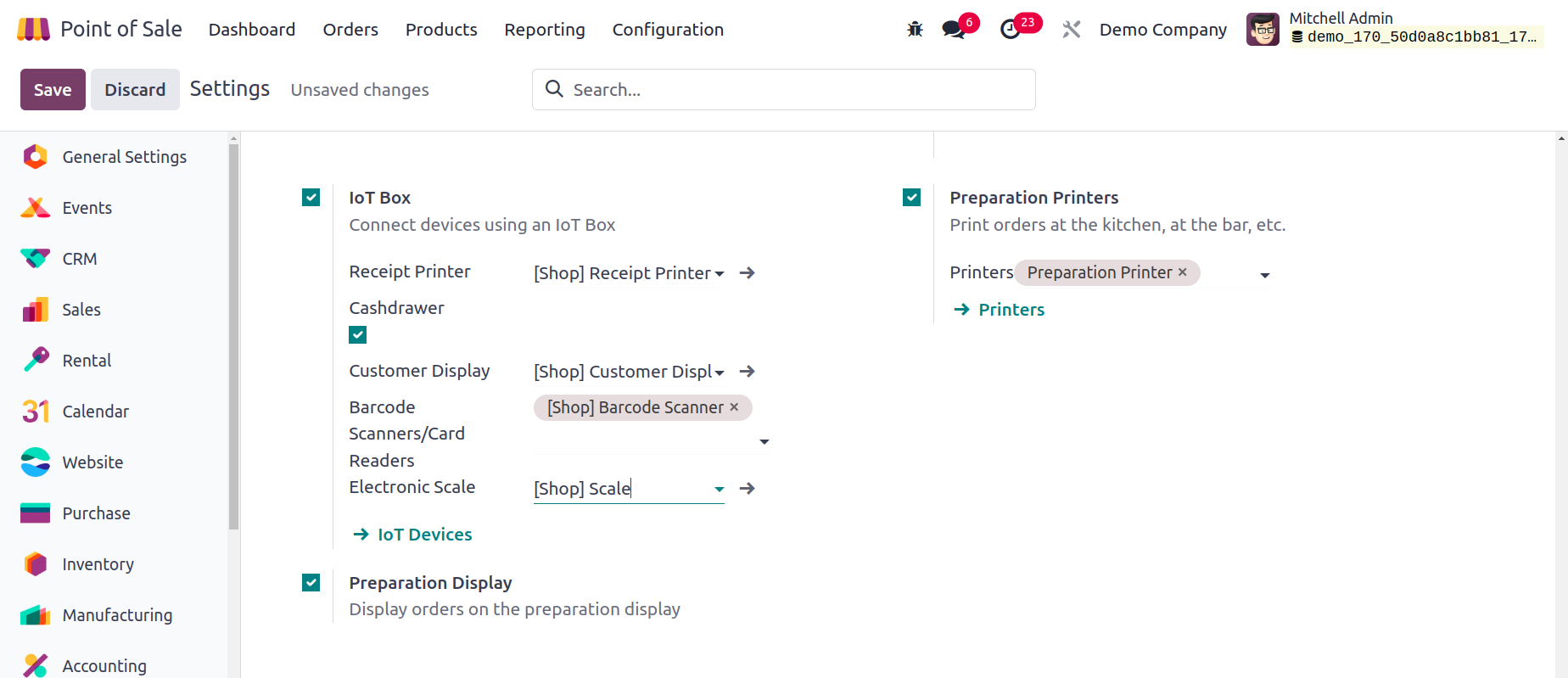
Orders were shown on the Preparation Display using this display.
Inventory
You can choose the Operation Type used to record the product pickings
under the Inventory tab. By putting the Barcode Nomenclature in the
appropriate location, you can use barcodes in PoS to scan products,
customer cards, and other items. By utilizing barcodes, you can
speed up PoS procedures. Once developer mode is enabled, the PoS
interface will display a debug window, as illustrated below.
The product's barcode can be manually entered using this window.
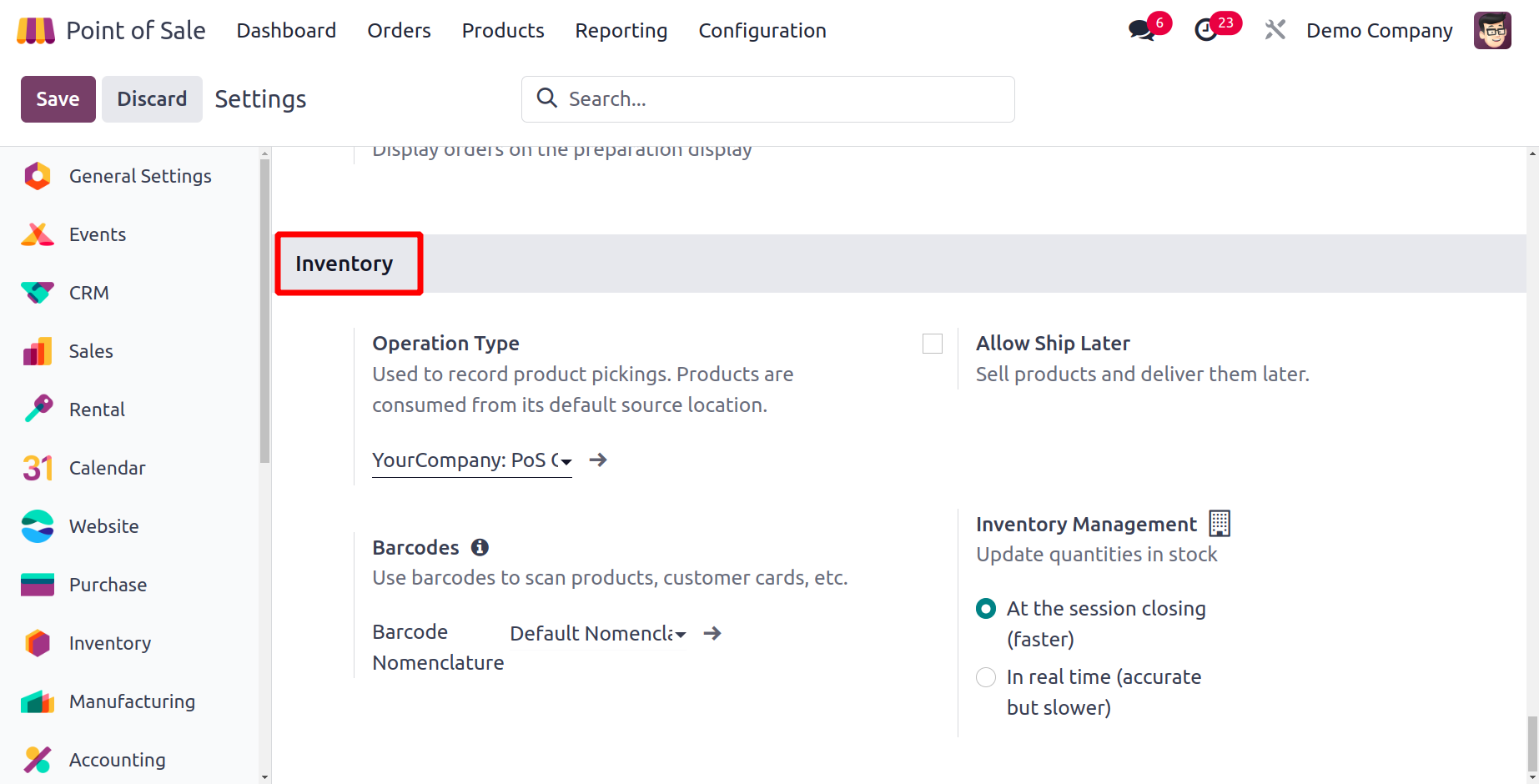
By turning on the Allow Ship Later functionality, you can use your
PoSsession to sell goods first and send them later.
You must specify the Warehouse, Specific route, and Shipping Policy
of such products in the appropriate areas in order to enable this
capability.
The Inventory Management specifics of this PoS might be mentioned in
this Inventory tab. You can choose when to update the stock
quantities here. Depending on your needs,
you may set it to either At the end of the session or In Real Time.
Only after the session has ended will the inventory be impacted by
the stock adjustments made during the end of the session.
In Real-time, stock changes impact the inventory concurrently.
The freshly established PoS is visible on the Dashboard of your PoS
module, as illustrated in the screenshot below.
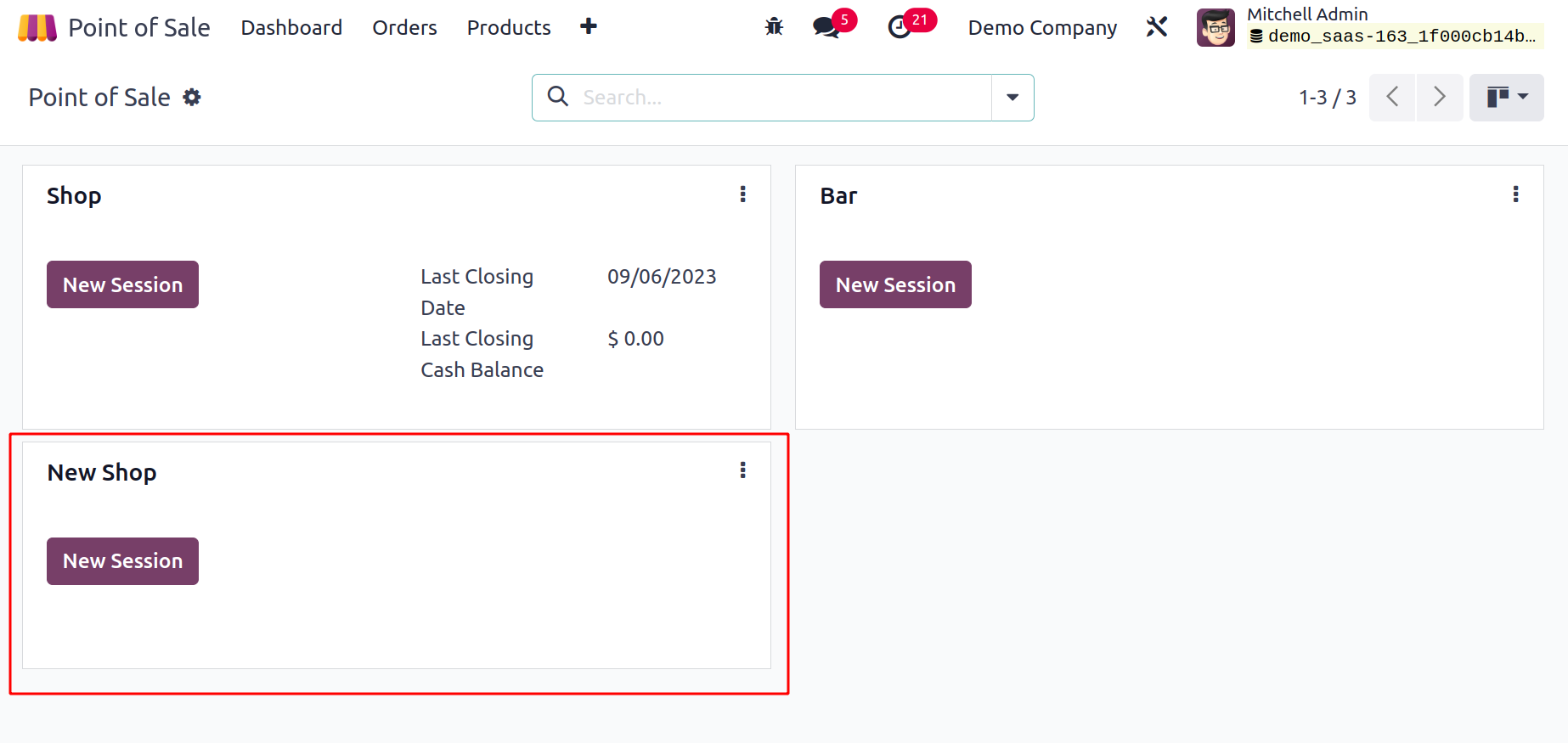
You can launch a new session for your freshly formed PoS by selecting
the New Session button.